Critters #1-50 edited by Kim Thompson.
Ah, funny animals… It’s such a strange genre, if that’s the name for it. Perhaps “stylistic convention” is better. You have anthropomorphic characters in basically any genre (humour, science fiction, mysteries, anything), and there are fans that are really into reading stories in all these genres as long as the characters are drawn as anthropomorphic characters.
I don’t mind anthropomorphics at all. Some of my best friends are funny animals. But I’m not a fan per se. That is, I’ll happily read a good science fiction story where all the characters are anthropomorphic, but I would have read that story even if the characters were more traditional human. Or alien. I don’t really care.
Critters is totally funny animal, and it’s very genre diverse. Serious stories nestle up close to stories very appropriate for young children. The only thing they have in common is the anthropomorphism. And there’s obviously an audience with a taste for this meta genre: Critters is (by far) Fantagraphics’ longest running anthology.
I remember growing somewhat tired of the anthology after a while, and I think I stopped buying somewhere in the mid-20s. I don’t remember why, exactly. But looking at my stash here, I’ve somehow, over the years, managed to buy all the issues I’ve missed, mostly at sales and stuff. So from some point on, I have not read these issues in sequence, but at random. And since most of the pages of Critters are filled with continuing serials, I’m kinda excited to finally read the entire run in sequence.
I think this is going to be one of those long posts…
Thompson has an editorial in the first issue where he tries to explain why Fantagraphics is publishing a funny-animal anthology… but he doesn’t really. Instead he talks about reading a great Carl Barks story. Which is a funny-animal story; sure, but it might as well serve as an explanation to an anthology devoted to stories about being lost in the Andes… Or something…
Anyway, we start off with some very early Usagi Yojimbo story by Stan Sakai.
It looks quite different from “mature” Sakai, but it’s already pretty darn attractive. I’ve been reading Usagi Yojimbo on and off ever since (more on than off). Sorting some boxes the other week I was a bit surprised to find that my Usagi comics had come to fill an entire short box… I guess I must really like it.
The Cutey Bunny story by Joshua Quagmire starts off with an explanation (sort of) of why there’s isn’t much Cutey Bunny in the story. And, indeed, it ends like this:
Spoilers! Is this a big “fuck you” to the editor? Or what? It’s quite odd, whatever it is. But good! It’s a good little non story…
And then there’s Birthright by Steven Gallacci. This is probably the most popular serial in Critters, and it’s easy to see why. It seems like a very complex, fully realised science fiction universe, with mature story telling (i.e., while there are some infodumps like the one above, things happen kinda… obliquely).
There’s a coup, and then a revolution, and then another coup…
And the art is really attractive. I mean, look at those people. And don’t look at those backgrounds, because it’s just airbrush and washes. Gallacci’s very handsome figures seem to mostly just hang around in a blank space (sometimes hanging more literally than at other times, like when they’re in zero gravity in a space ship somewhere). But still, it’s really enjoyable too look at and to read.
On the last page, Thompson explains about the Cutey Bunny thing. While Joshua Quagmire was the one to give the impetus to start Critters, they had a falling out, and Quagmire was not featured in any other issues of the series. Except! (Skip to the end of this article for the exciting conclusion to this epic grudge match! (Just kidding! (Not about the conclusion, though.)))
So, a very, very good first issue.
The second issue featured the introduction of the Gnuff serial by Freddy Milton. His artwork is incredibly Carl Barks-like, but not in a slavish way. I mean, just look at that pose the dragon in the last panel strikes. It’s so Donald Duck, but in a well-integrated way. And the story is hilarious and exciting — perhaps more like one of the good Floyd Gottfredson serials from the 30s than Barks… Or a mash up.
And Critters is apparently a hit. It was (at the time) the biggest selling black and white comic Fantagraphics had published at 14K copies. Mind you, this is in 1986, during the post-Teenage Mutant Teenage Turtle black-and-white boom, so pretty much anything sold, but it’s still impressive.
And these were also the days of the Jack Kirby petition (and the Marvel Boycott). Kirby wanted his original artwork returned from Marvel, and they wanted him to sign a retroactive work-for-hire contract before doing so. Blackmail, pure and simple. It was quite a scandal, but pre-Internet, so there’s probably not that much on the web about it? I binged for it right now, and the only thing I could find was about another recentish petition and boycott over a related issue. Plus ça change, plus c’est la même chose.
I did stop buying Marvel comics as a result, and I didn’t read any super-hero comics until a decade ago…
Back to the Critters! While Milton’s art and timing owes a lot to Barks, his stories are more overtly political. Dragons are a semi-persecuted minority, so you have imagery like the above. But this also leads to the head councilman (I think) giving Gnuff a series of jobs (that he bungles) because of affirmative action. Right. Milton’s politics are hard to pin down?
While the main serials (Usagi, Birthright and Gnuff) continue to satisfy, Thompson also drops in lots of delightful shorter stories, like this one where Ty Templeton does a pitch perfect homage to Walt Kelly. Almost every issue the first year has something unexpected. It makes for a very satisfying reading experience, even if the letters page has a number of correspondents complaining about paying a whopping $2.00 (inflation adjusted price $4.32) for a black and white (gasp) 32 page comic.
The editor is always optimistic. I don’t think any such graphic album was ever published, which is a shame…
Here’s Tom Stazer having fun with anthropomorphic conventions: Lionheart dreams that he’s performing on stage in just his underwear, while in much of the strip he’s completely pantsless, wearing just a jacket.
Like that.
More bits of interest from Gnuff: Is that a nice thing for our protagonist to do? Spraying paint into the faces of the security guard? As the Gnuff serial progressed, I found it less and less exciting to read. It’s a combination of increasing nastiness (but not very nasty, don’t get me wrong) and the sense of fun disintegrating.
Or perhaps the stories just weren’t that much fun. I found the entire Orva saga to be somewhat of a chore to get through.
Gotta love this Ty Templeton artwork. His lines are just so insanely crisp.
On the other hand, you have the Lizards by John Holland and Ron Wilber. It’s probably the first serial that’s a complete miss for me. The dialogue is all like this: Like somebody threw a hundred made for TV scripts into a blender and used that as a papier-mâché base for the word balloons.
This is from the first story, and it does not improve over time.
Wilber’s art is… uhm… well, I could see how some people would enjoy it.
Sam Kieth shows up in a few issues with somewhat deranged non stories. They’re fun and the artwork is nice, but I just wanted to point out how early these “isz” creatures show up in his work. (They’re featured heavily in his most famous series, The Maxx, starting some years later.)
The first of many editorials about decreasing circulation and paper quality (my favourite subject). Thompson notes that they’re only printing 12K copies now. I think this is the last time he mentions a number — after this it’s “bad” or “worse”. And this is only issue 13!
Things can get confusing in funny-animal land… (From Blue Beagle by Tim Fuller.)
I was wrong! Down to 10K.
By this point, Usagi had gotten his own bunny warrior comic, so one of the most reliable cartoonists was gone. Instead it’s totes hilair things like this comic by Jim Engel. (To explain the joke: The pig has very, very bad recall.)
Gnuff is so political! Anyway:
I’m including this page because 1) it’s gorgeously drawn by William van Horn in his Walt Kelly/George Herriman mash up style, and 2) the paper stock is the most horrible one I’ve ever seen. Not only is it bleeding from the other side of the page, but you can see through it to the next page, too.
Thompson explains in the editorial a couple issues later (#23) that the printer was shipped the wrong type of paper and didn’t tell Fantagraphics.
Tough guy talk! Oh, and 9K.
I be digging this Ty Templeton artwork. (And the story was really funny, too.)
Mike Kazaleh! He does funny accents, too, in addition to drawing very purdily.
That’s a joke.
Anyway anyway anyway, by this point (#28) I had originally stopped buying Critters a few issues ago, but this issue is the most perfect example of why I stopped subscribing. There are three serials going: Tim Fuller’s Blue Beagle (also shown above) which is an action/comedy satire featuring The Watchdogs (yes) and a plot by Collie North to… take over the US or something.
There he is. The second serial is by Tom Stazer and Anthony Smith which is an action/comedy satire featuring Walt Disney (or whatever they called him — Milt Whimsy? It’s been days since I read this thing and I no longer remember) and a plot by Ollie North to… take over the US or something.
There he is! And the third serial is by JP Morgan and is an action/comedy satire featuring Walt Disney, I mean Walt Ditsy and a plot by some corporate aliens to… take over the US or something.
You see where I’m going here? At the outset, Critters was wonderfully diverse, but at this point it felt like the action/comedy satires had swamped Critters completely, and they weren’t even very good. I mean, I dislike Ollie North as much as any sane person, but *zzz*.
The best of the bunch is probably Fission Chicken by JP Morgan, which is wilder and weirder than the other two, but it’s also not that… interesting.
OK, here we skip to issue 35, because I found nothing to say about anything happening in the seven preceding issues. But this is the thing I’m excerpting here:
This is by Kyle Rothweiler. The artwork isn’t unattractive — he’s going for a cluttered and zany effect, and it works, sort of. But the first joke here is an AIDS reference, and the second is about how feminists are so funny. Hilaire! It doesn’t continue in this way, but it doesn’t get any funnier, either.
The next issue Thompson announces that Critters would drop the anthology format and go to a one-feature-per-issue format:
And also dropping the page numbers (which started at about 30 per issue and was winnowed down a bit in later years) to about 22. Circulation, circulation.
Of note in these single feature issues is number 42, which continues the Captain Jack storyline. A bit.
It’s a sweet little story, and gorgeously drawn as usual.
Birthright continues for three issues in #47-49; the latter two were published after #50 (because Gallacci). Monika Livingston did the artwork over Gallacci’s layouts. The artwork is fine, but it’s not as striking as when Gallacci did it himself.
Reading the Birthright saga this time, though, Gallacci’s plotting seemed a lot creakier than when I was reading an issue here and there. Because Gallacci doesn’t hold your hand that much when reading, you get an impression of complexity and depth that’s not necessarily there.
At the end of the second Birthright arc, our heroes were saved by a helpful space ship that happened to swoop down when they needed it. This arc begins with the crew explaining to our heroes that the planet they’d been fighting over for two story arcs is basically a write-off, because the bad guys have decimated the population, and not in the Roman way. So off our not so merry band go to another planet, where… yes… they get involved with another fire fight, and then lots of factions and people plot and then it’s over.
So… Not as impressed this time.
But if you don’t think about the plot or structure too much, it’s pretty exciting nonetheless.
The final issue (well, number 50, at least) reverted to the old anthology format, and included just about everybody who’s done work for Critters over the years. But there’s also people doing their first work for Critters, like Arn Saba:
I think the artwork Saba did for this Neil the Horse story is totally gorgeous. I love all of Neil the Horse, but this is just lush.
Mark Marek’s story isn’t that funny or funny-animal:
Mm… meat…
And if you skipped to the end when I talked about skipping to the end, here it is! And surprisingly enough, it’s a Cutey Bunny story by Joshua Quagmire! But not only that, it features somebody who has to be that girl who was bombed in the first issue:
How’s that for rounding off the series. Everything connects. And then the final inside cover, which is a quote from the Neil the Horse story:
*sniffle*
So that’s it. There’s tons of really good stuff in Critters, and there’s quite a lot of mediocre stuff, too. But Kim Thompson really tried, and he succeeded for quite some time, in making a really entertaining magazine. That’s more than most people can say.
This post is part of the Fantagraphics Floppies series.
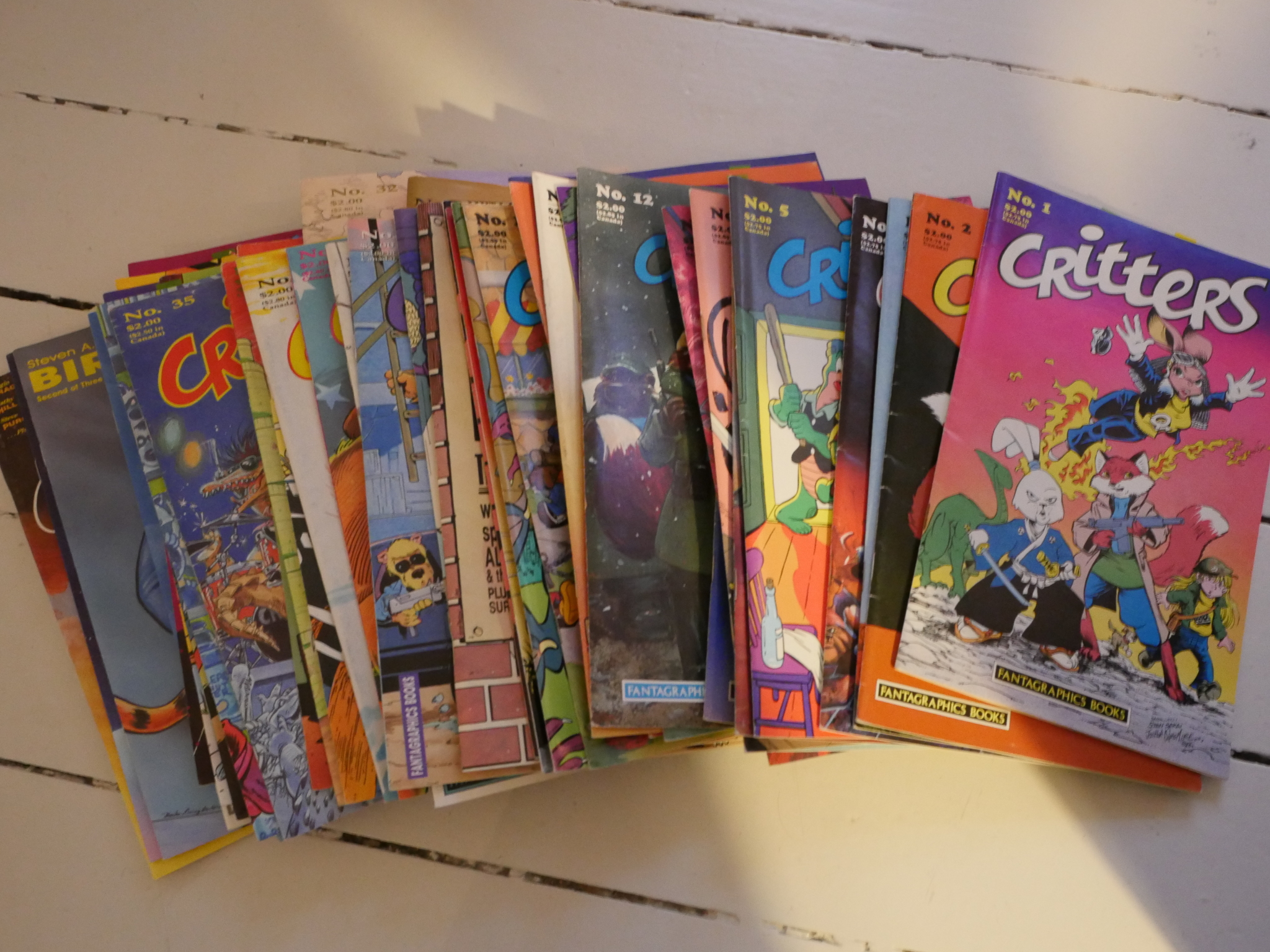
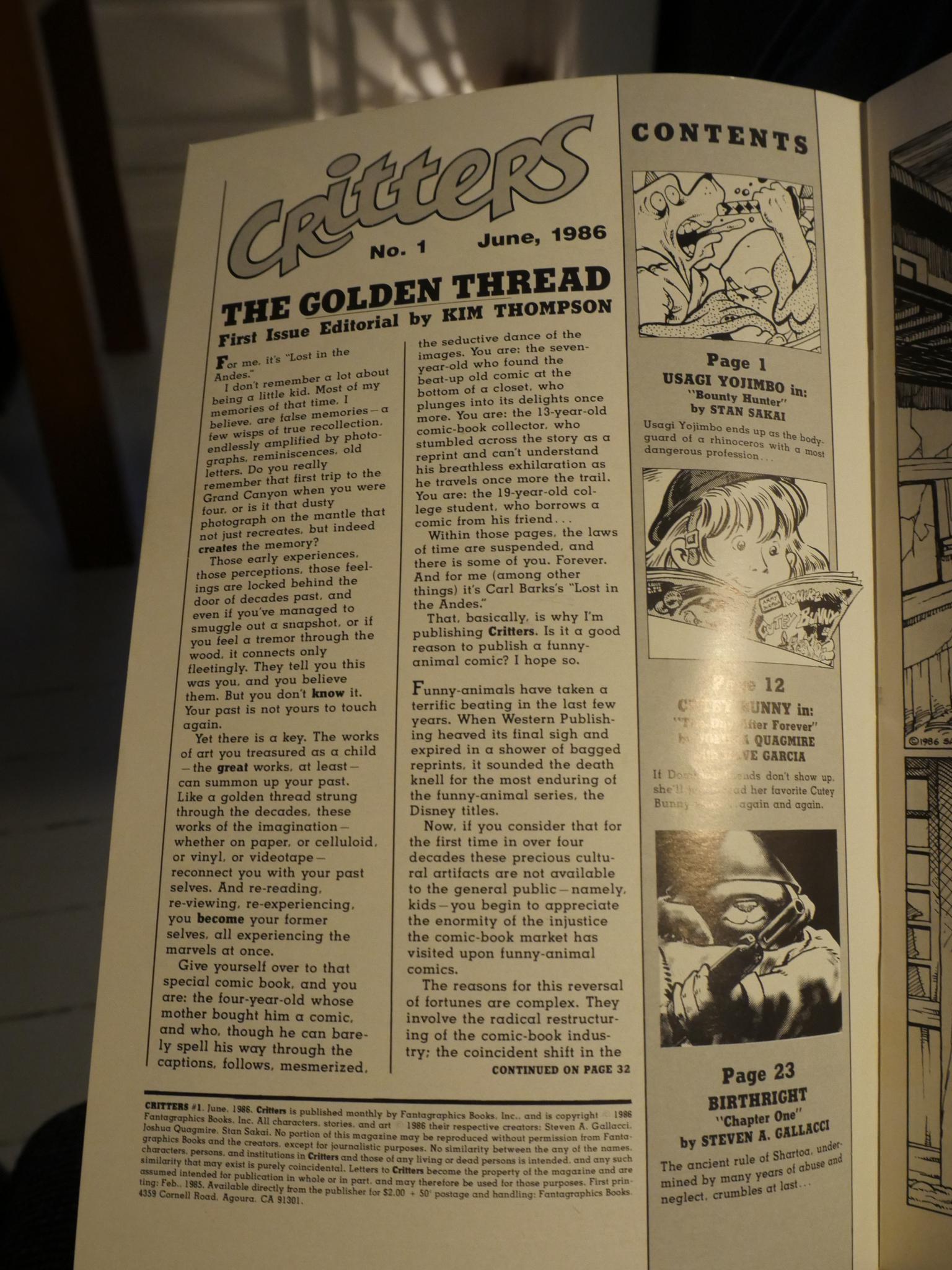
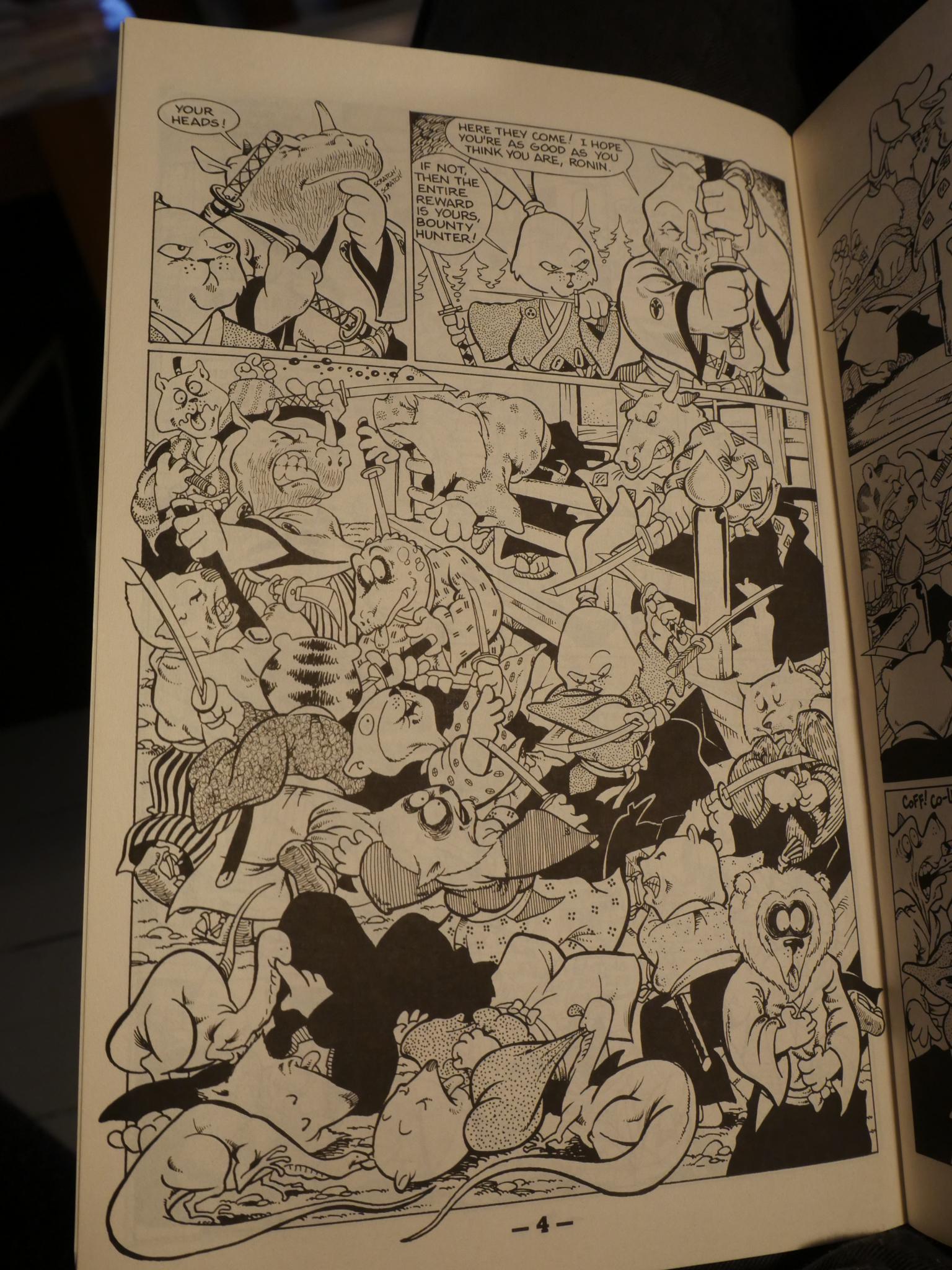
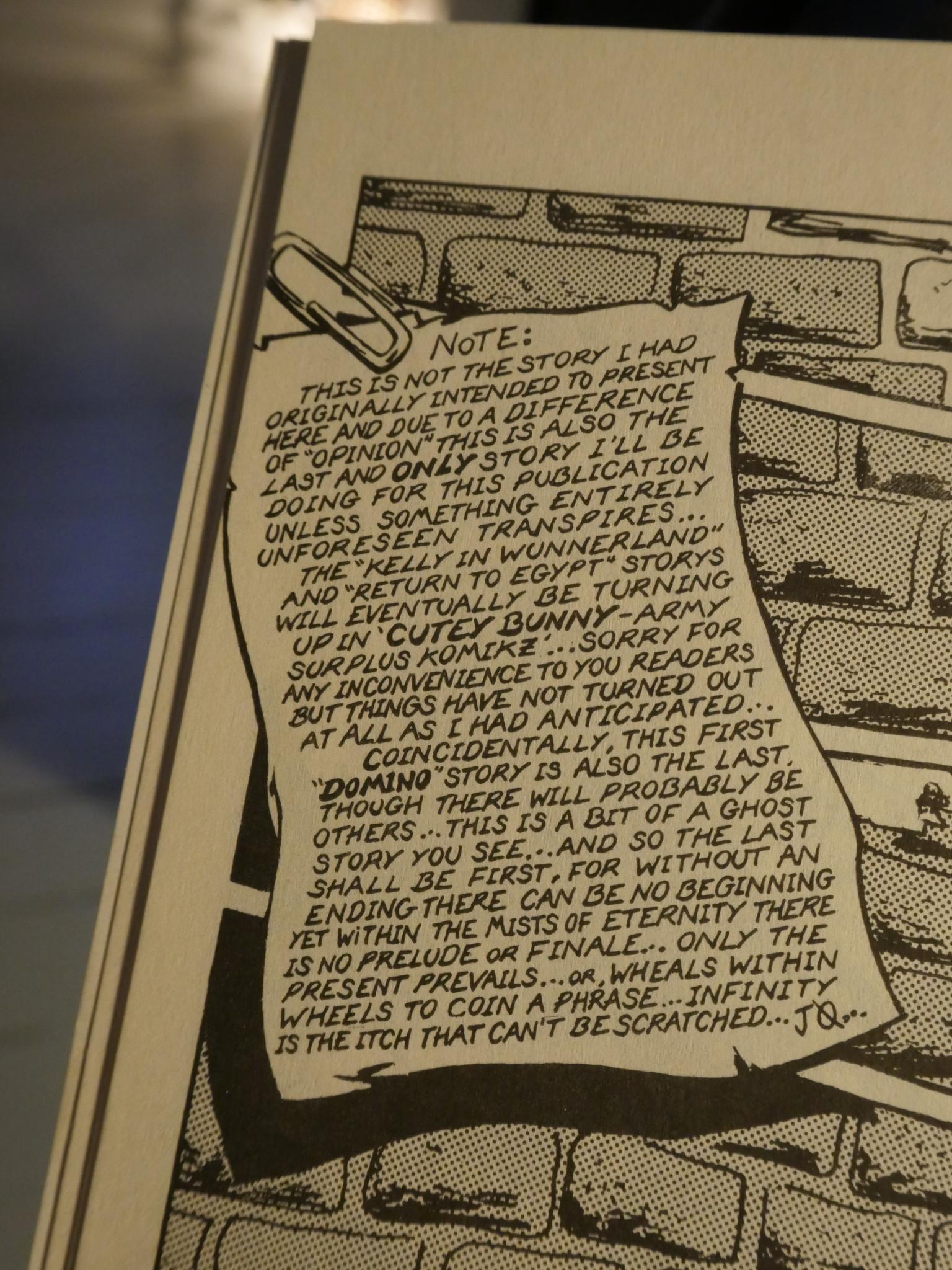
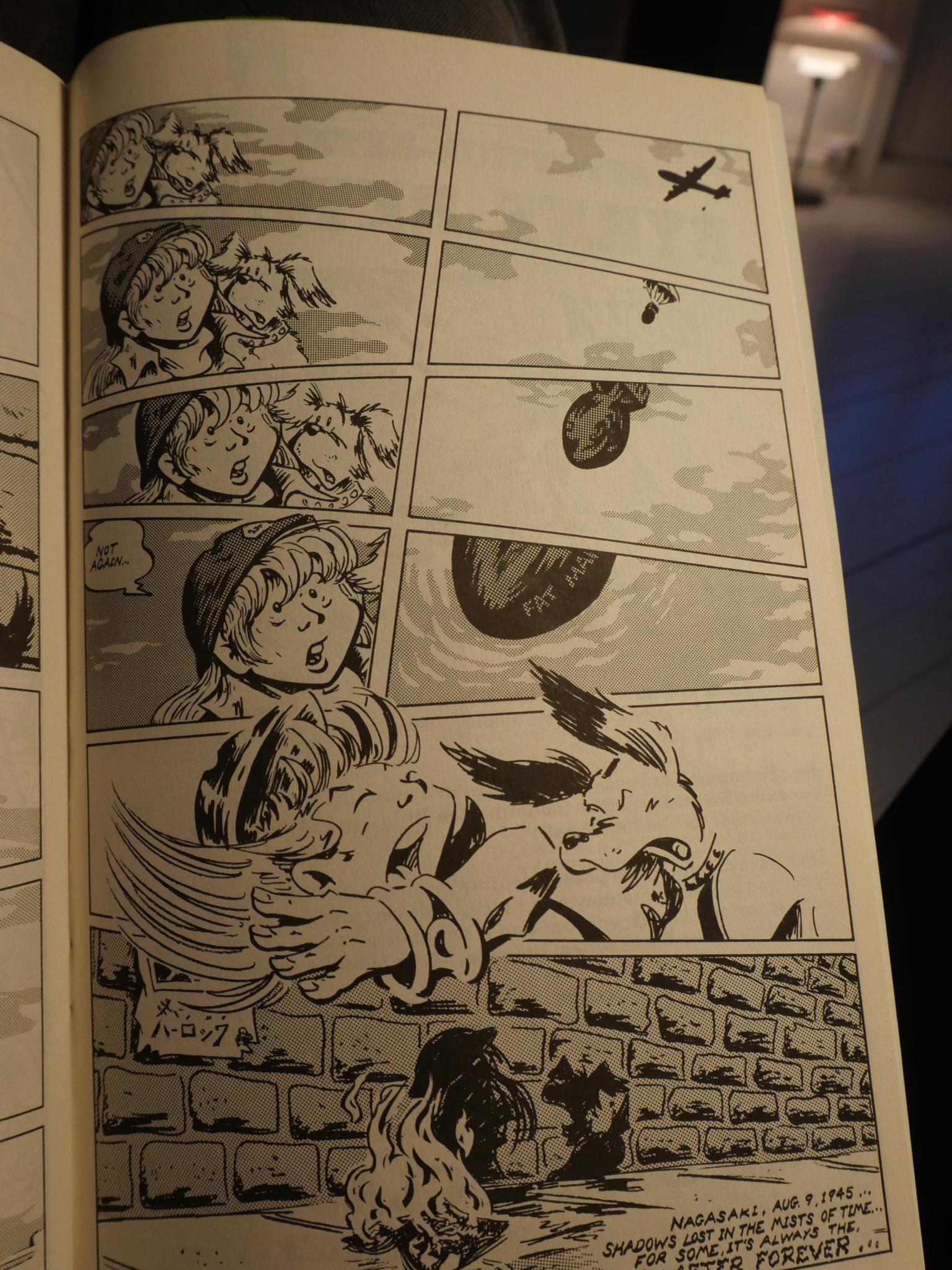
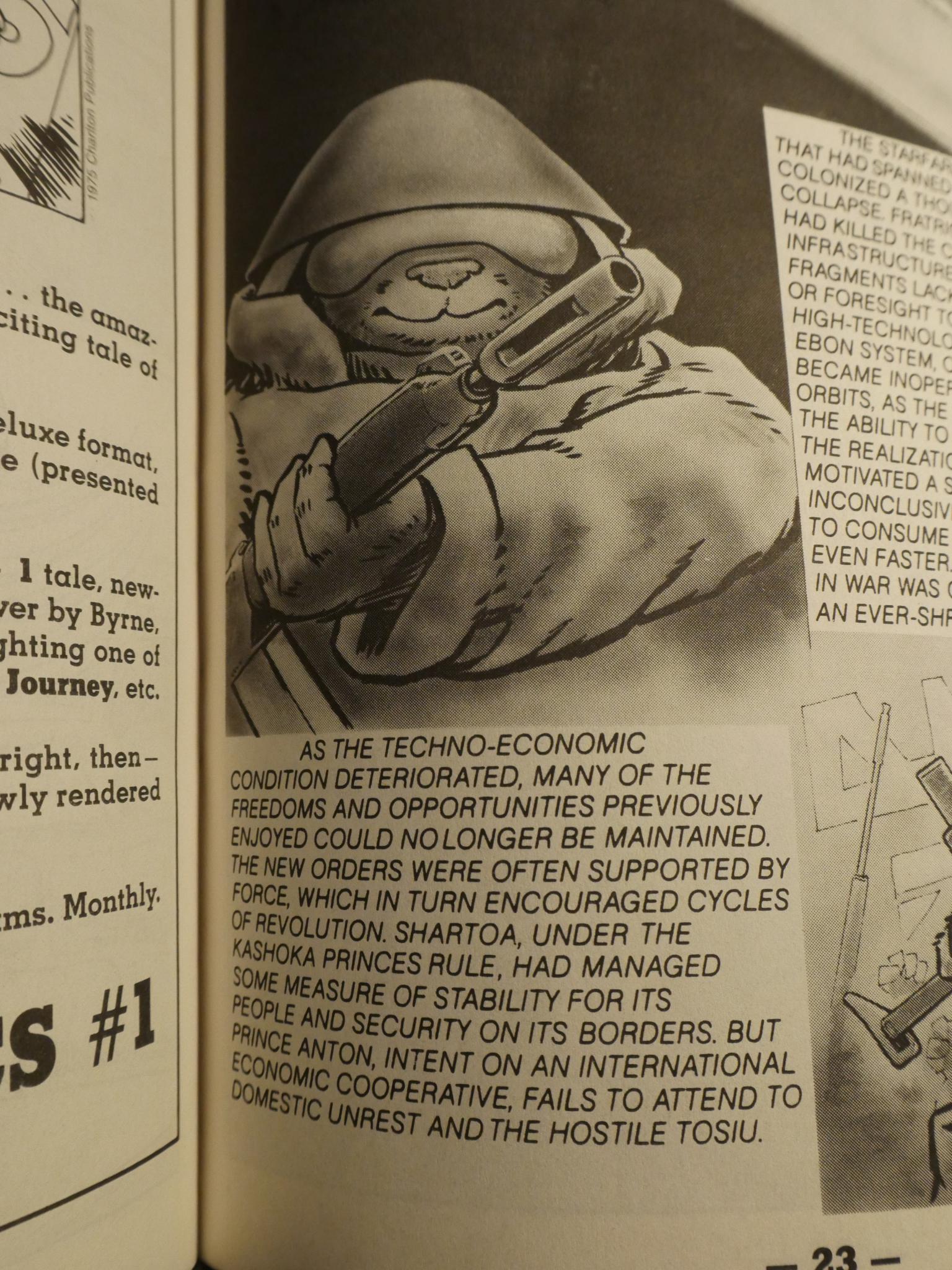
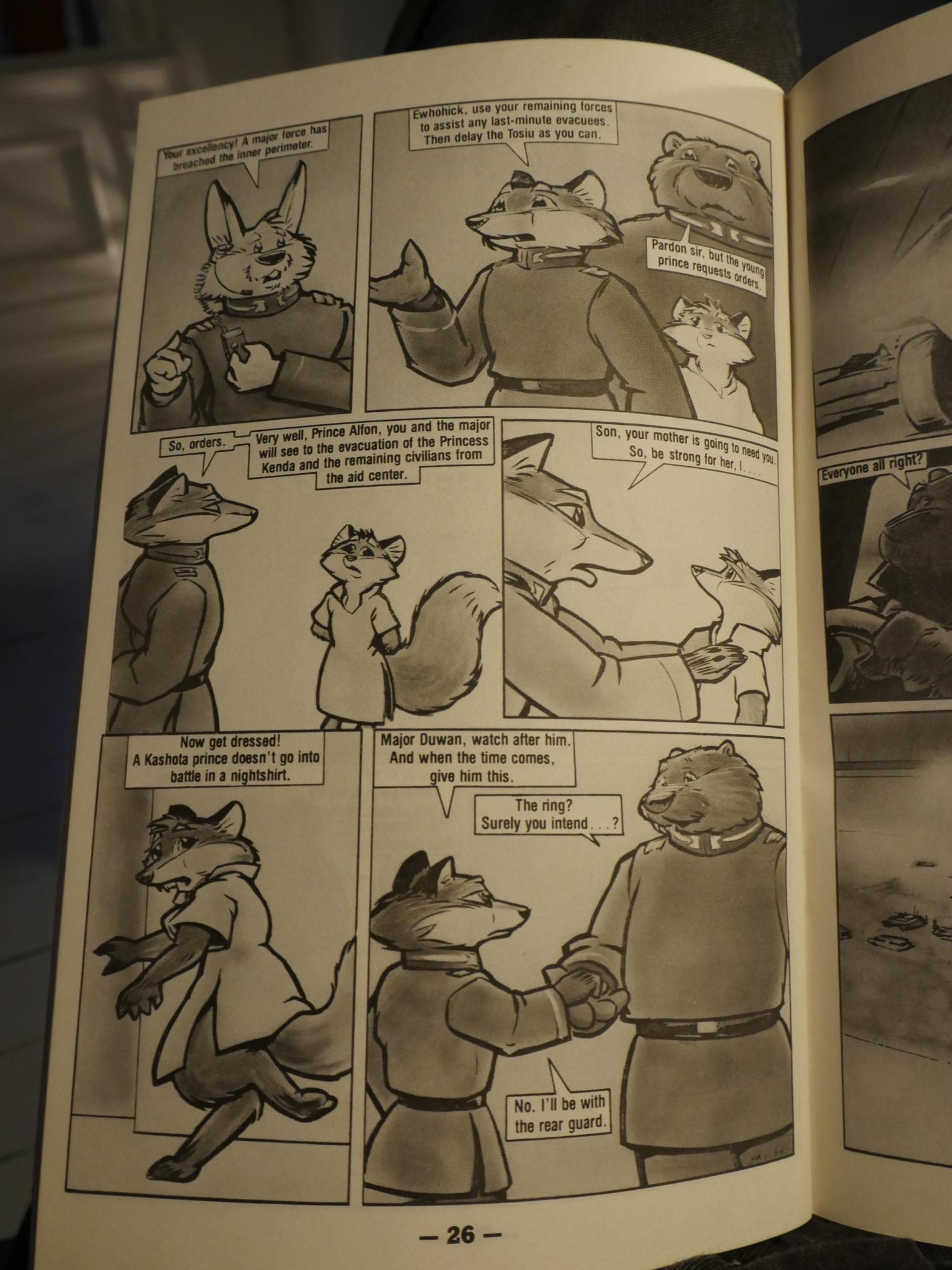
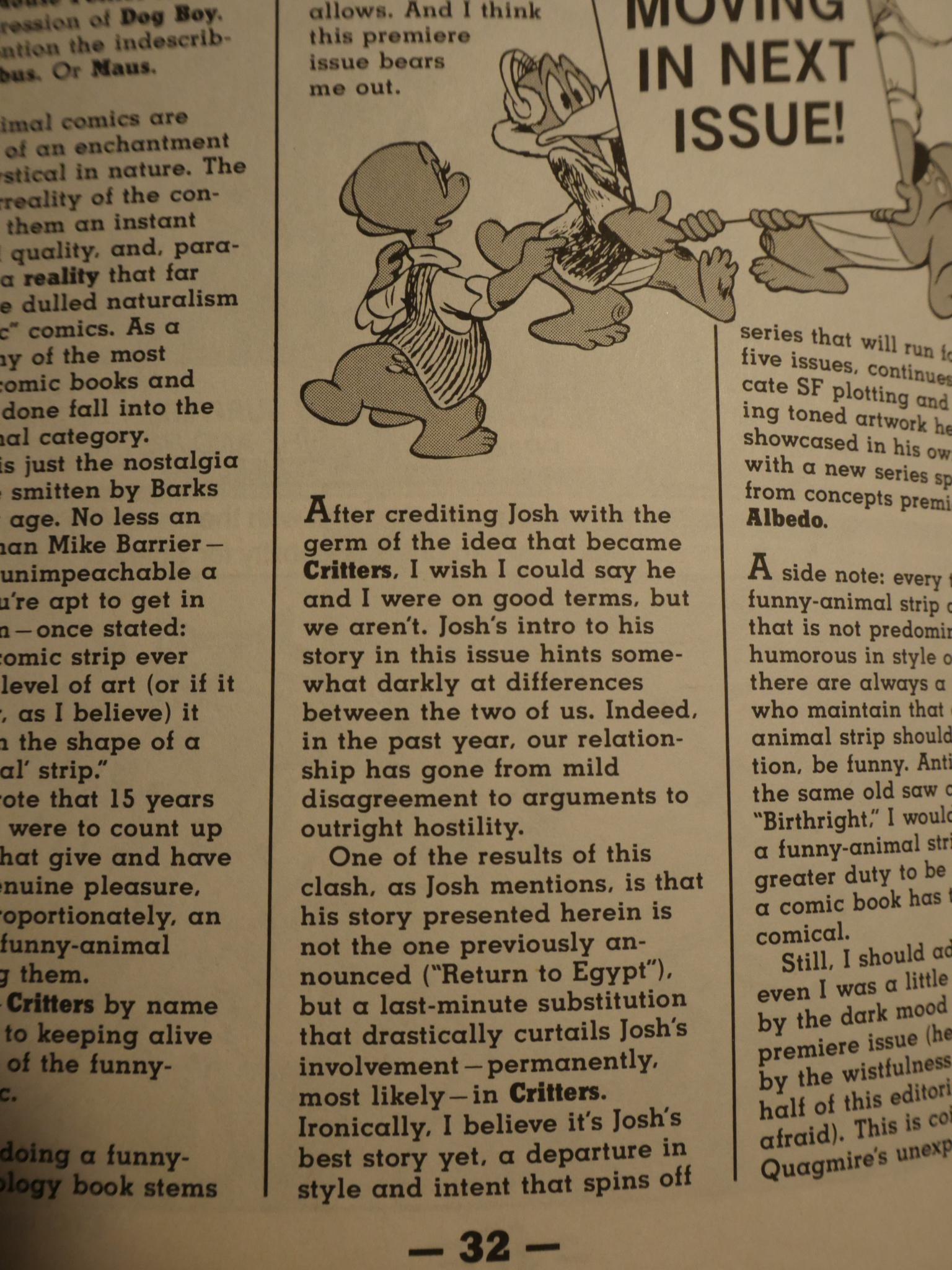
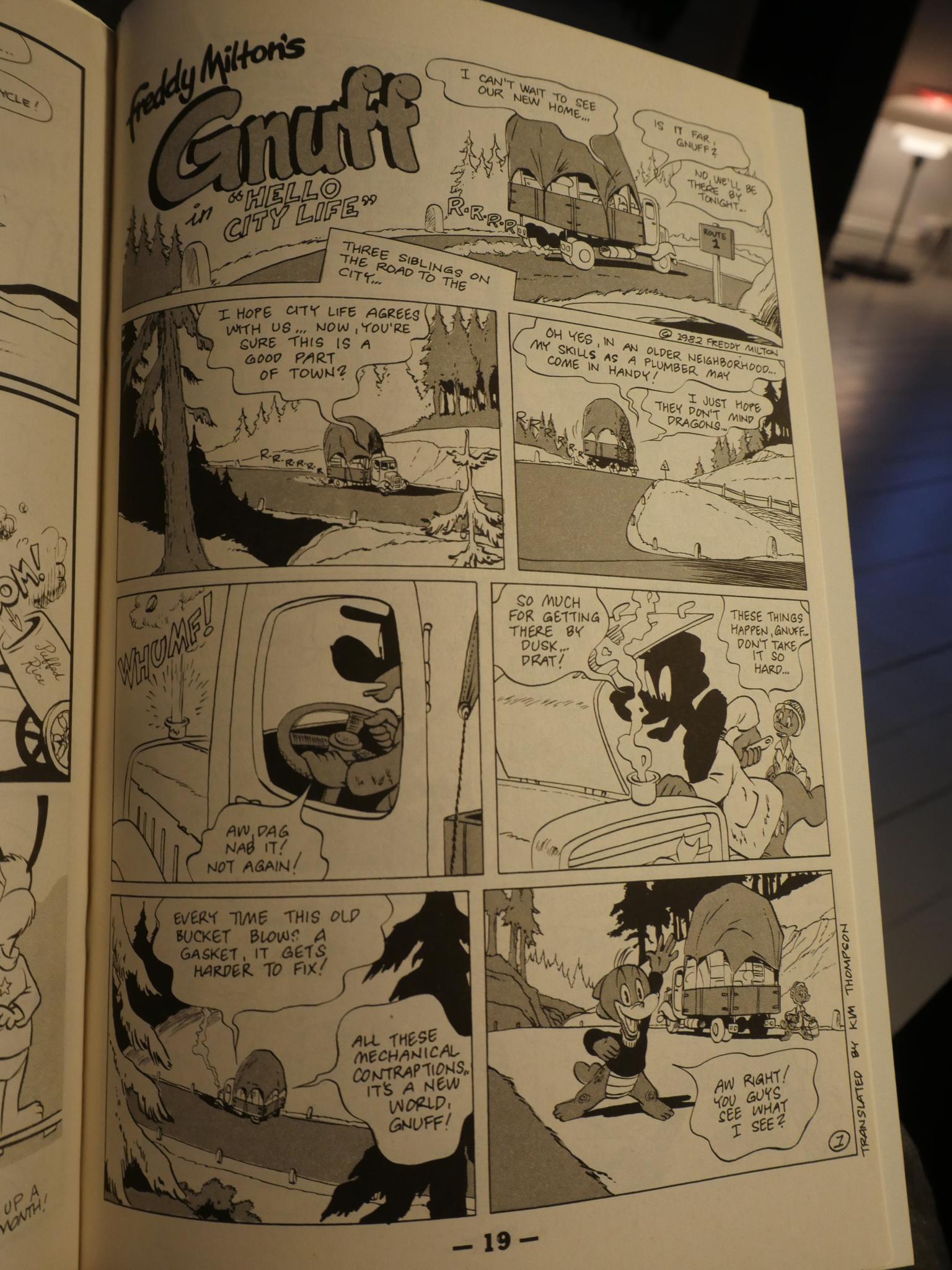
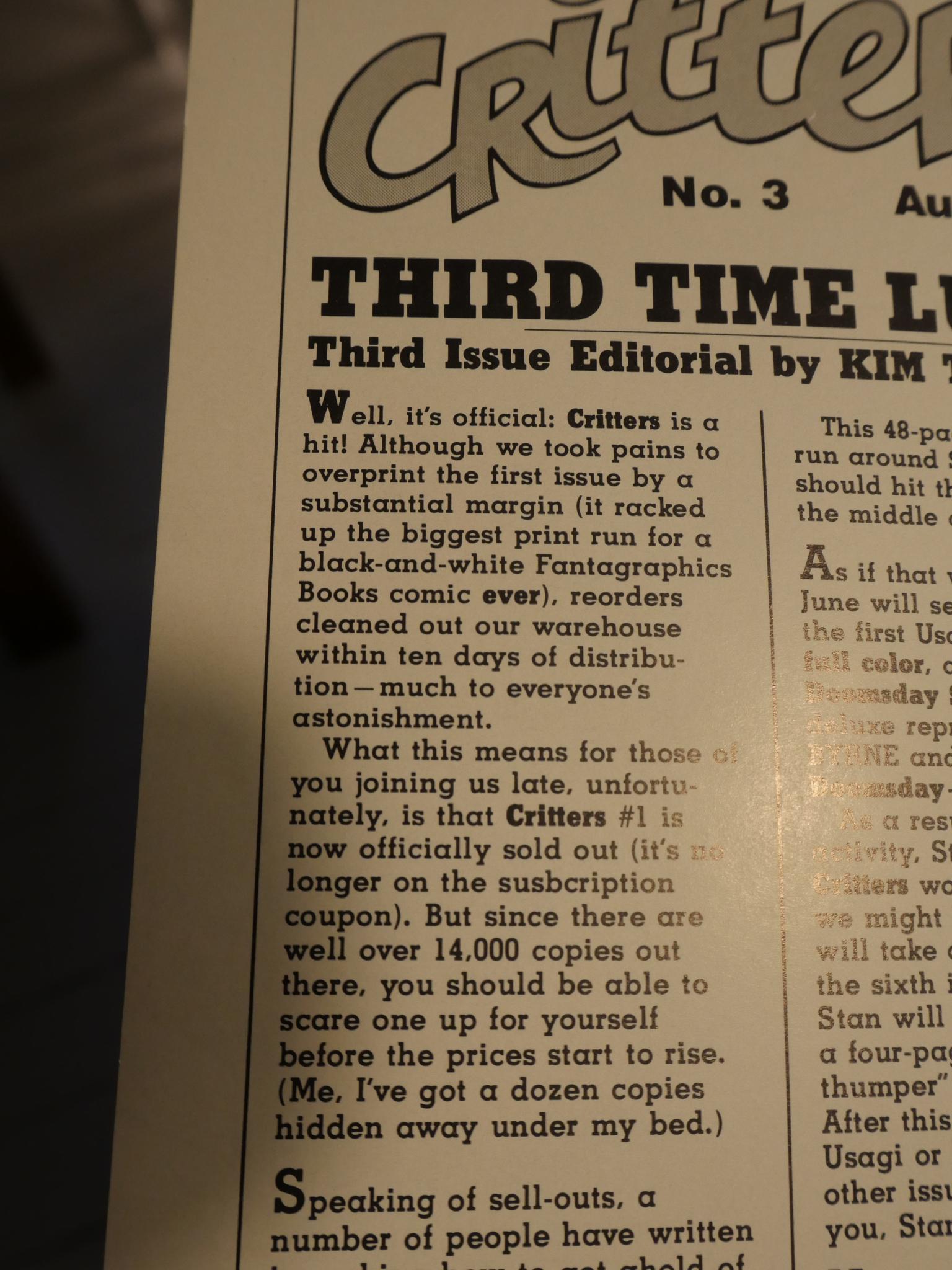

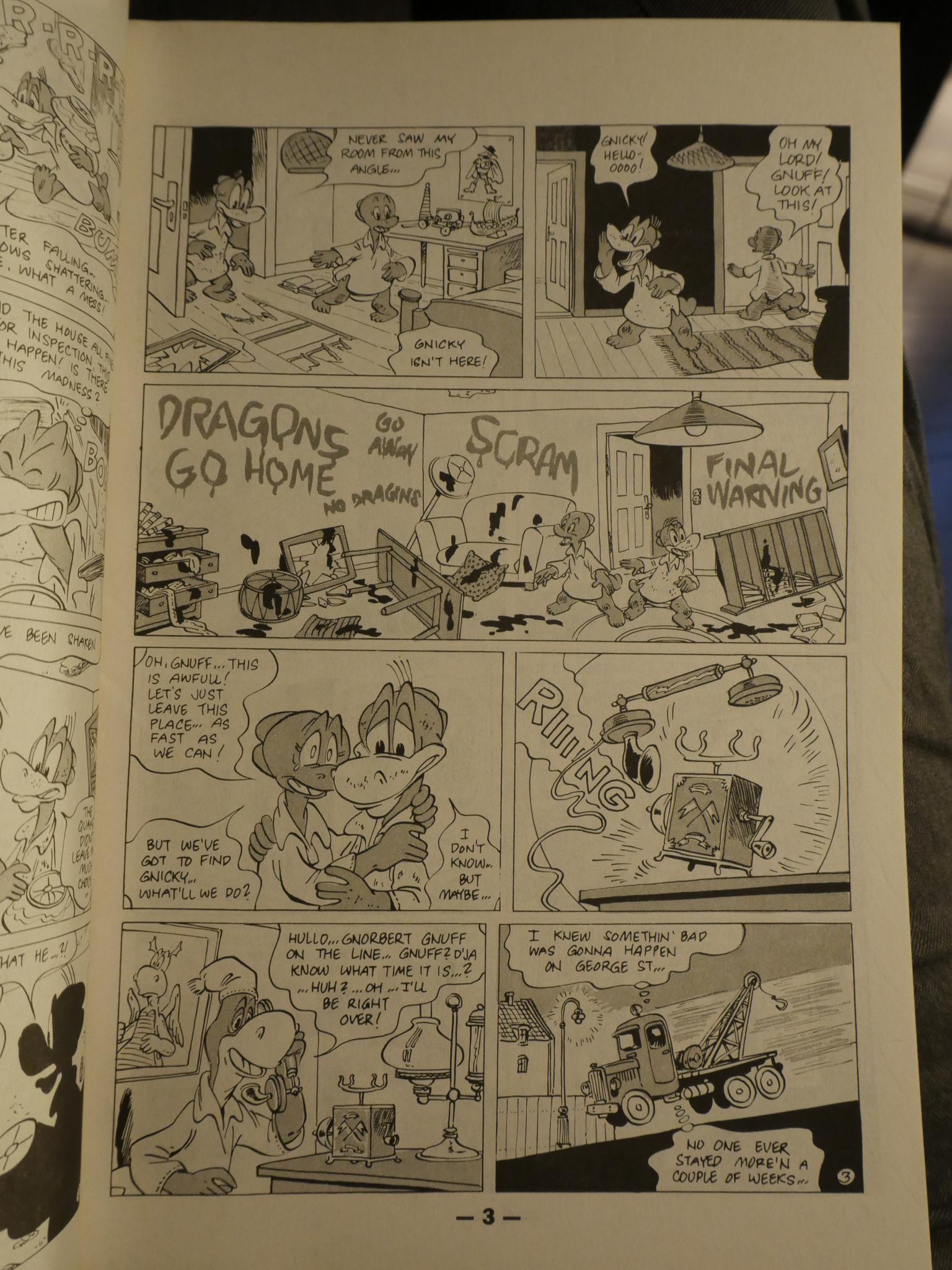
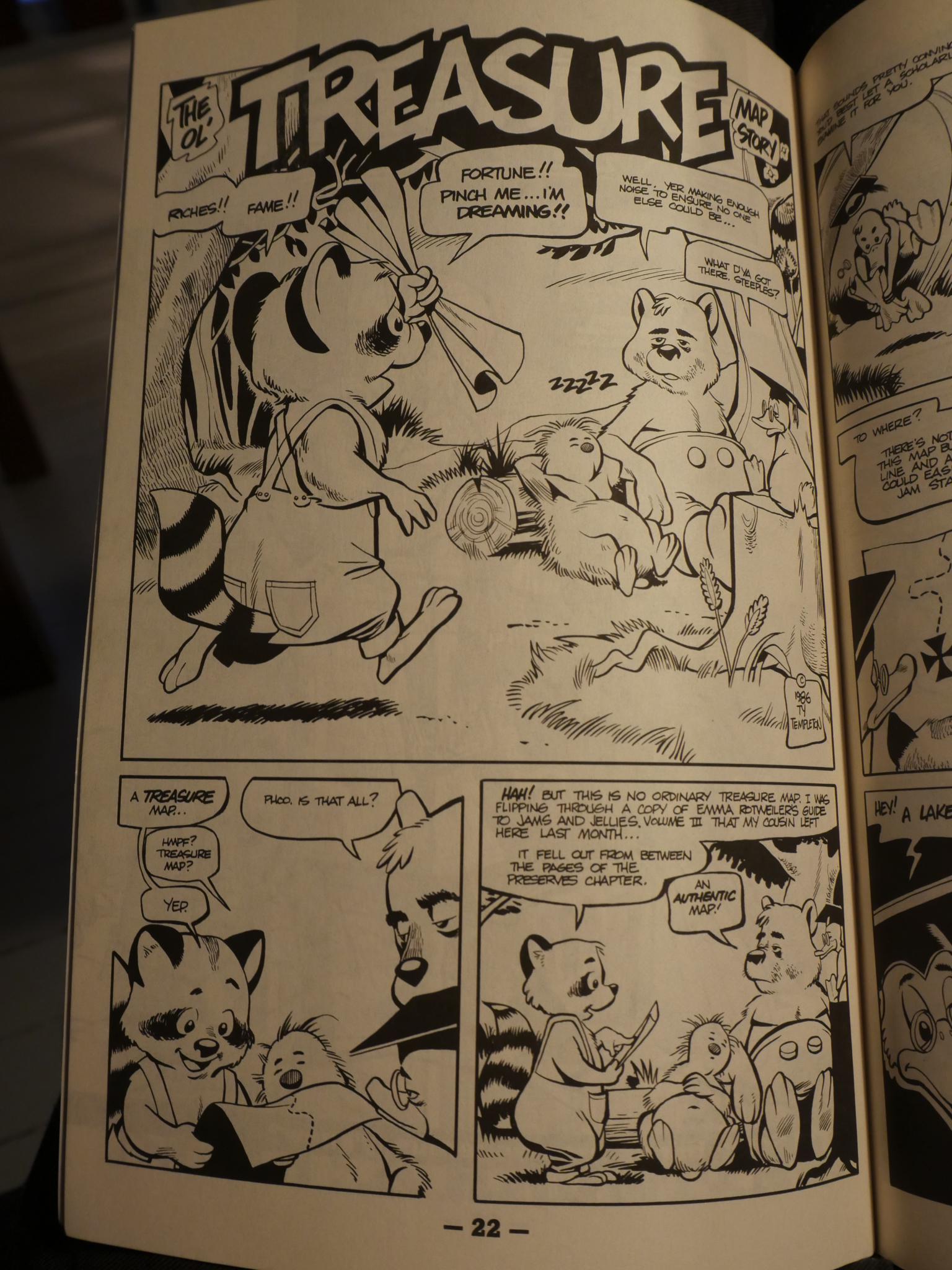
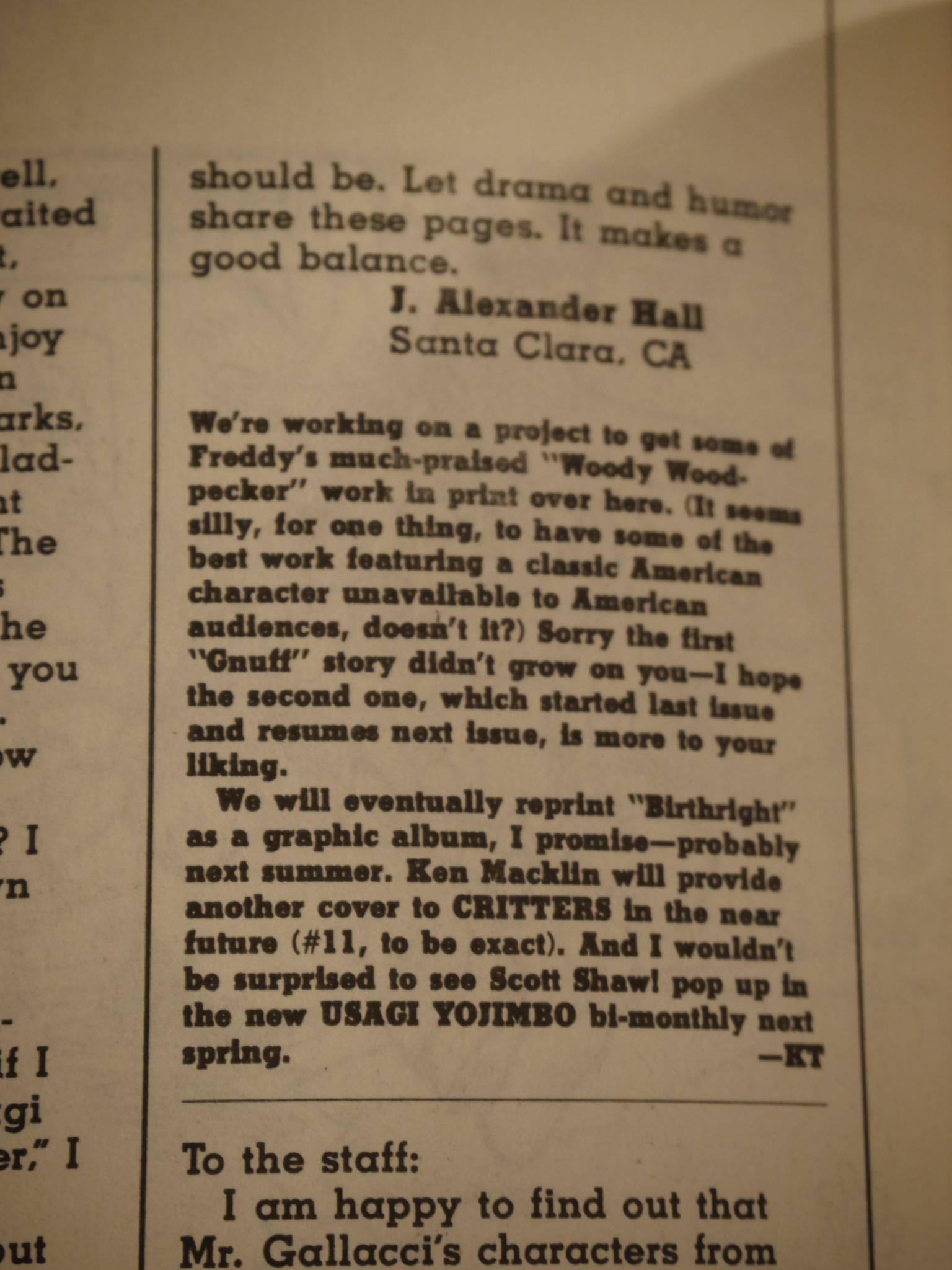
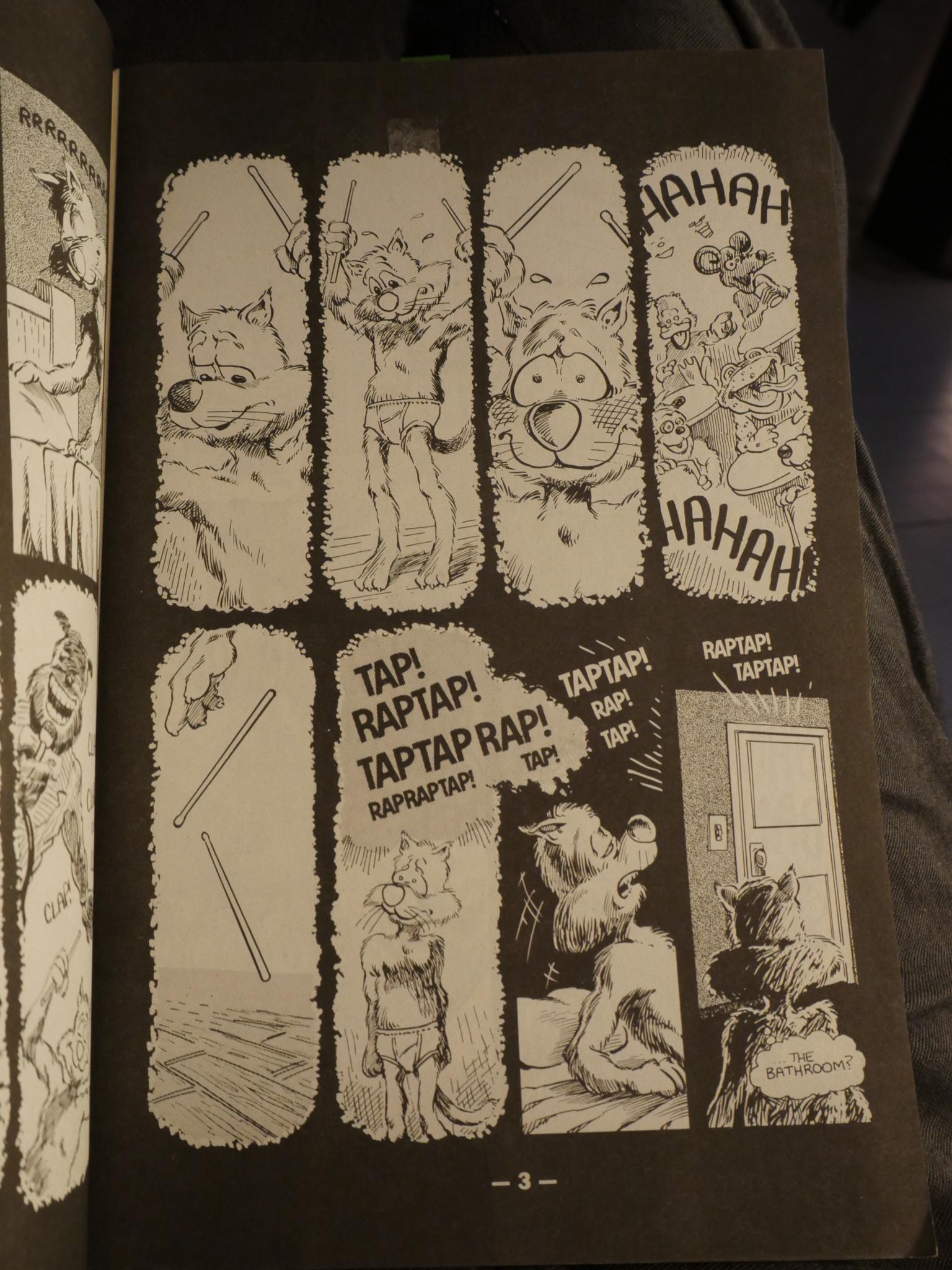
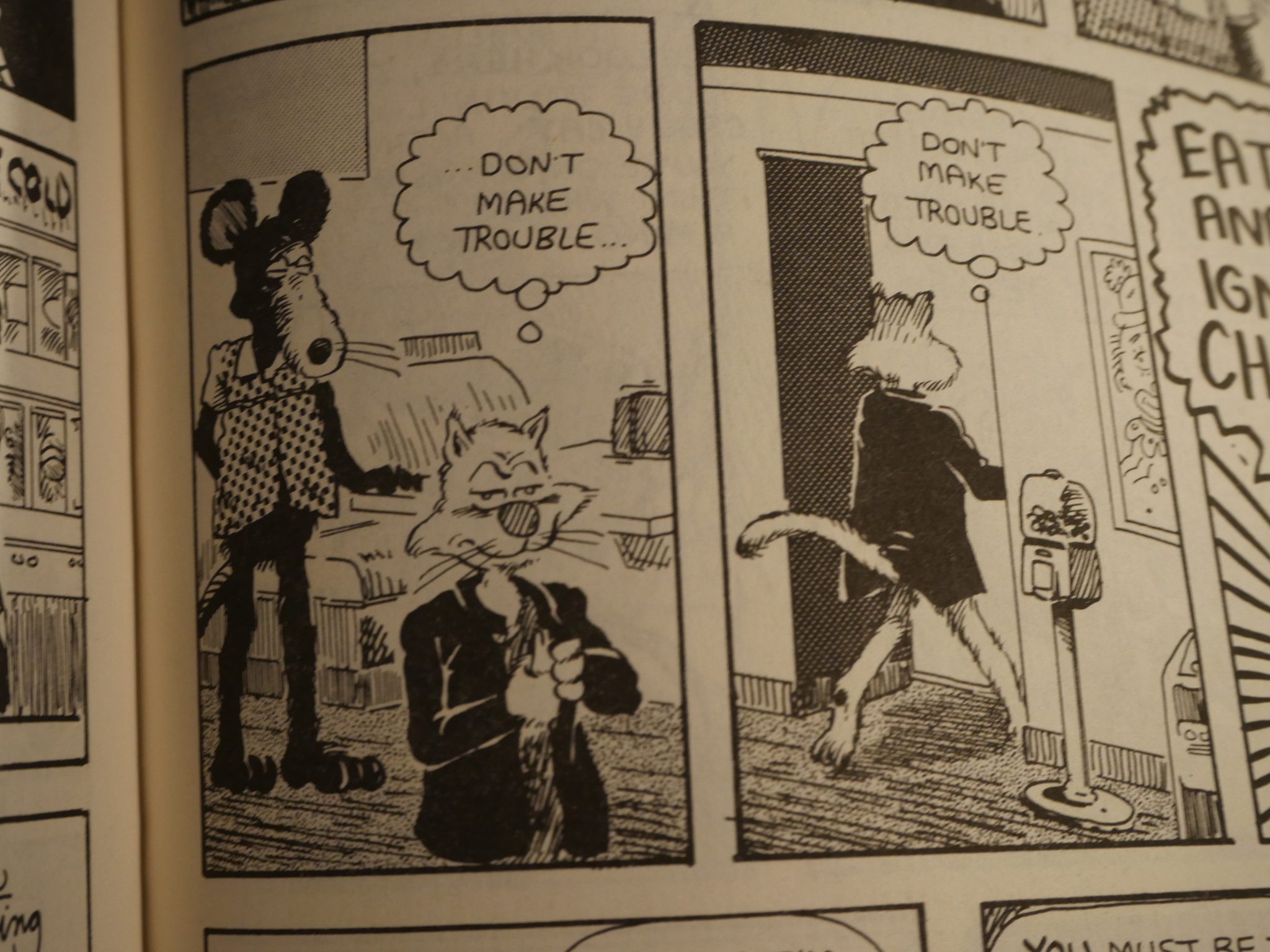
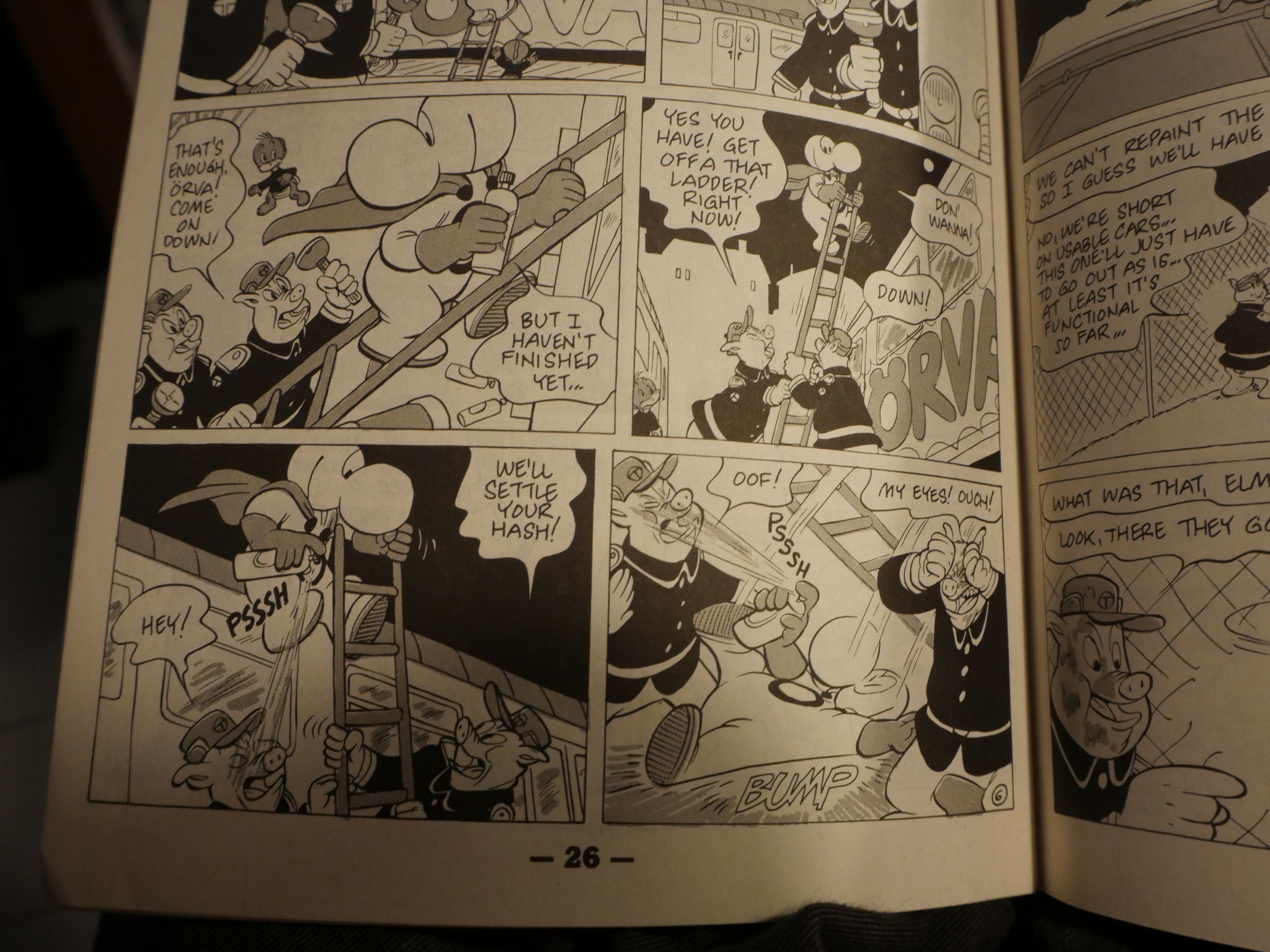

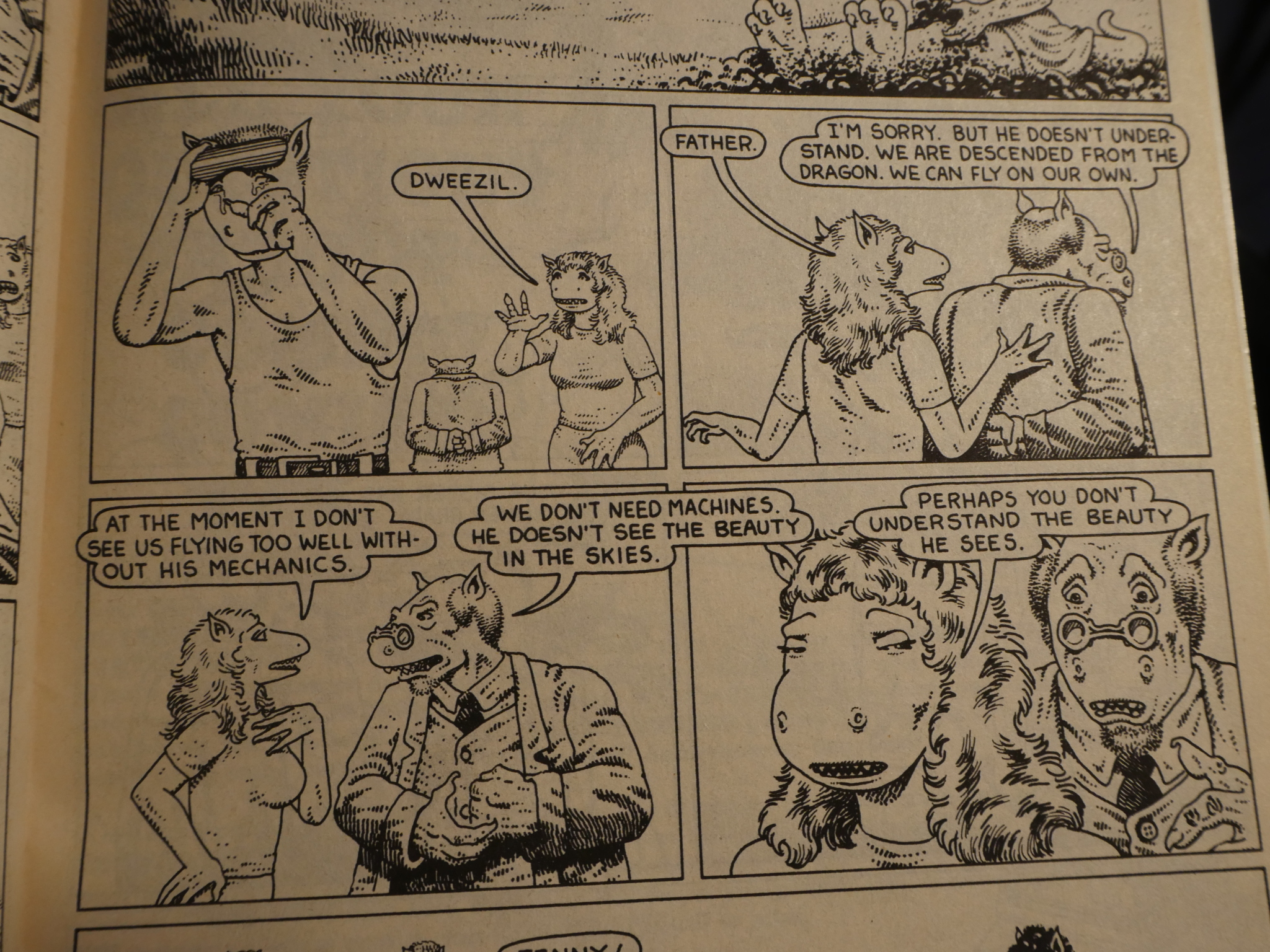
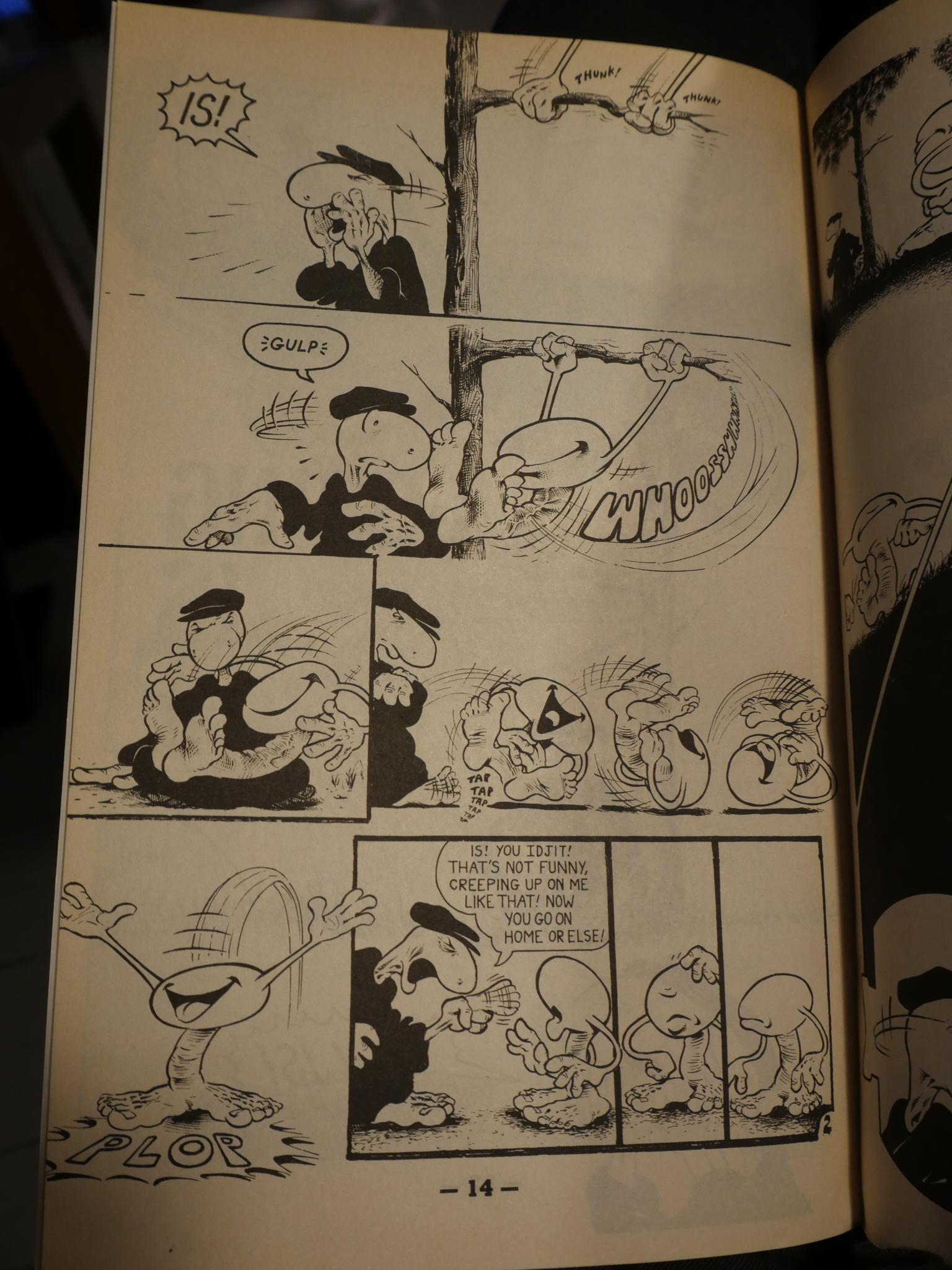


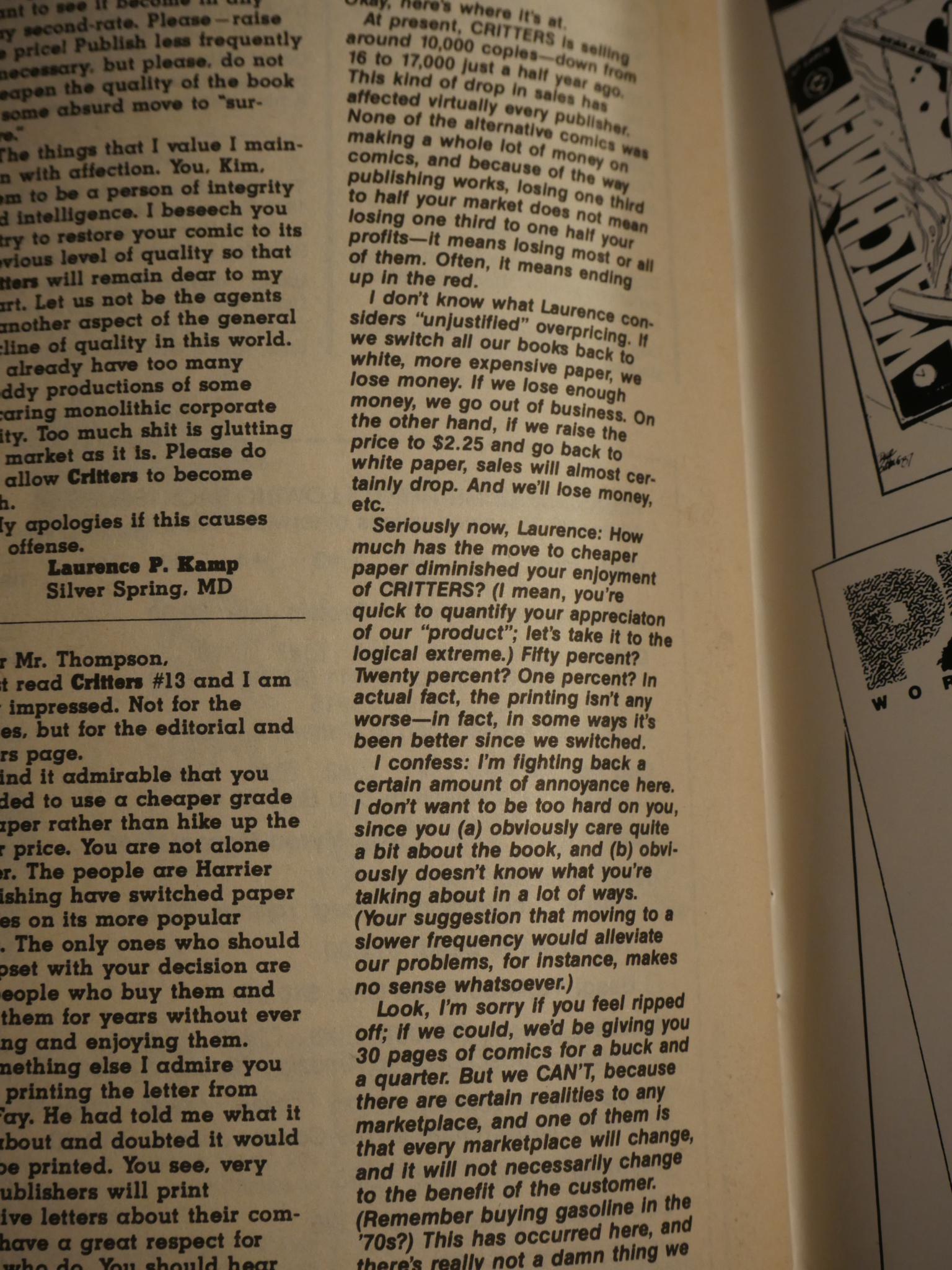
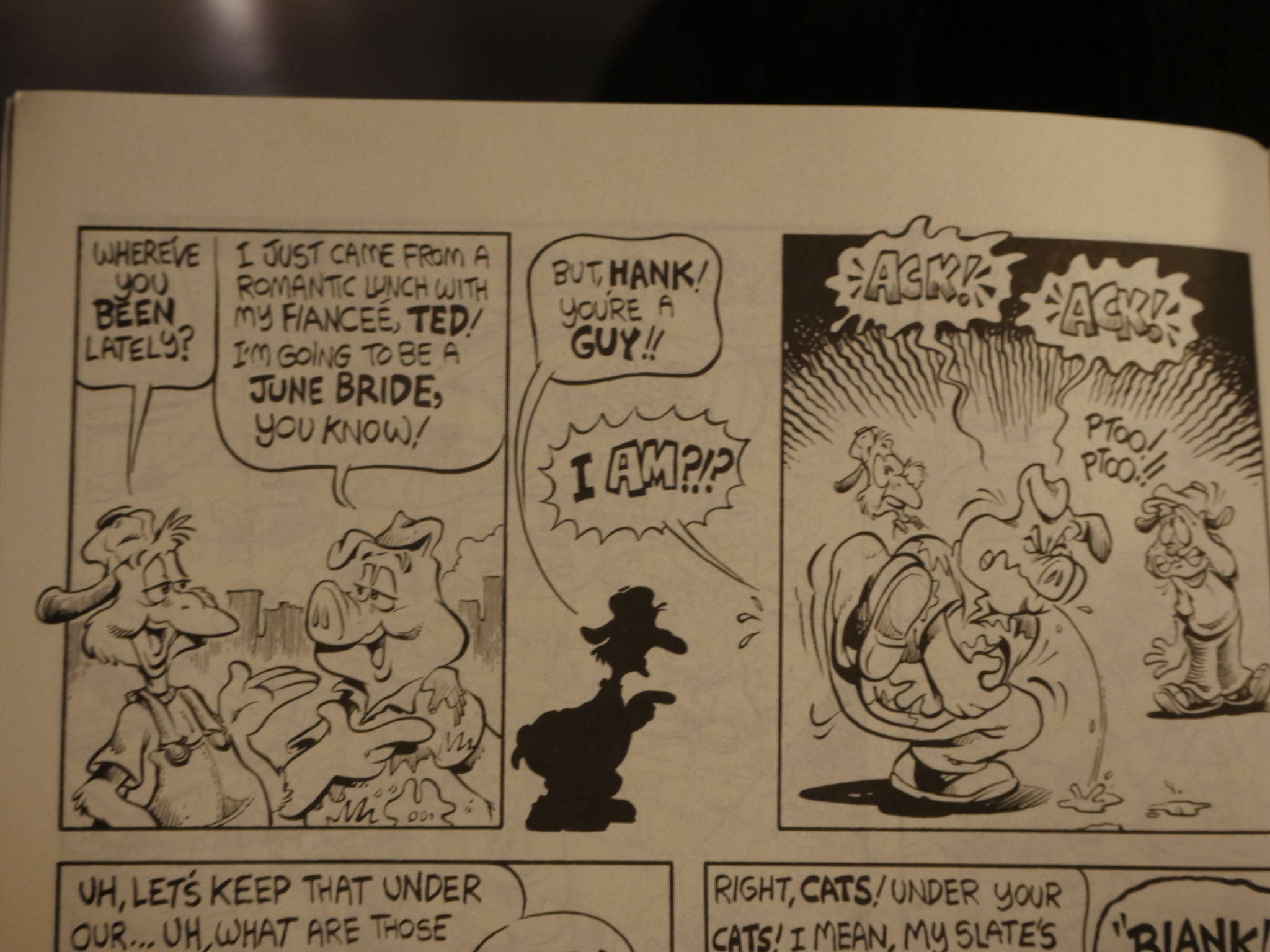
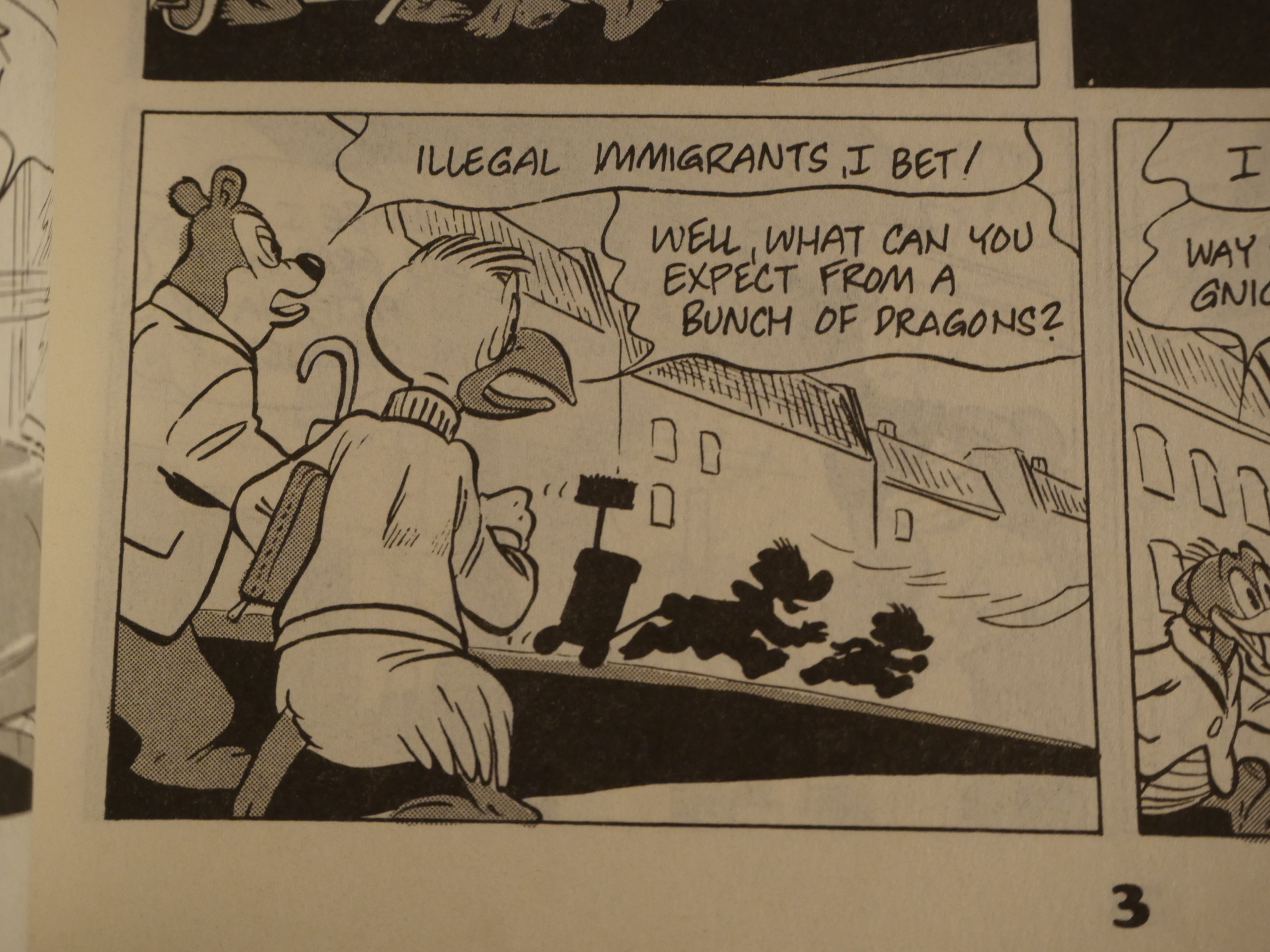
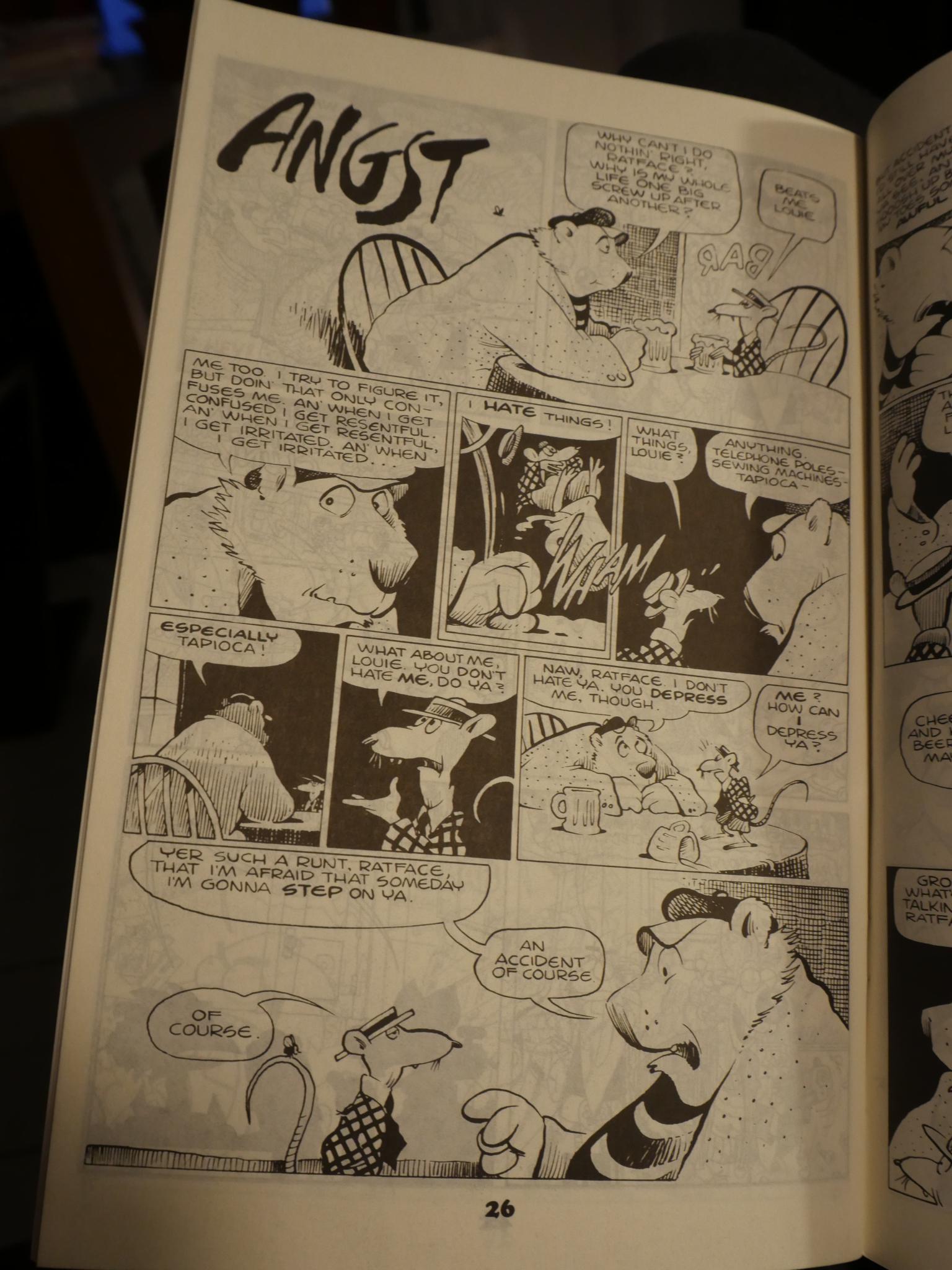
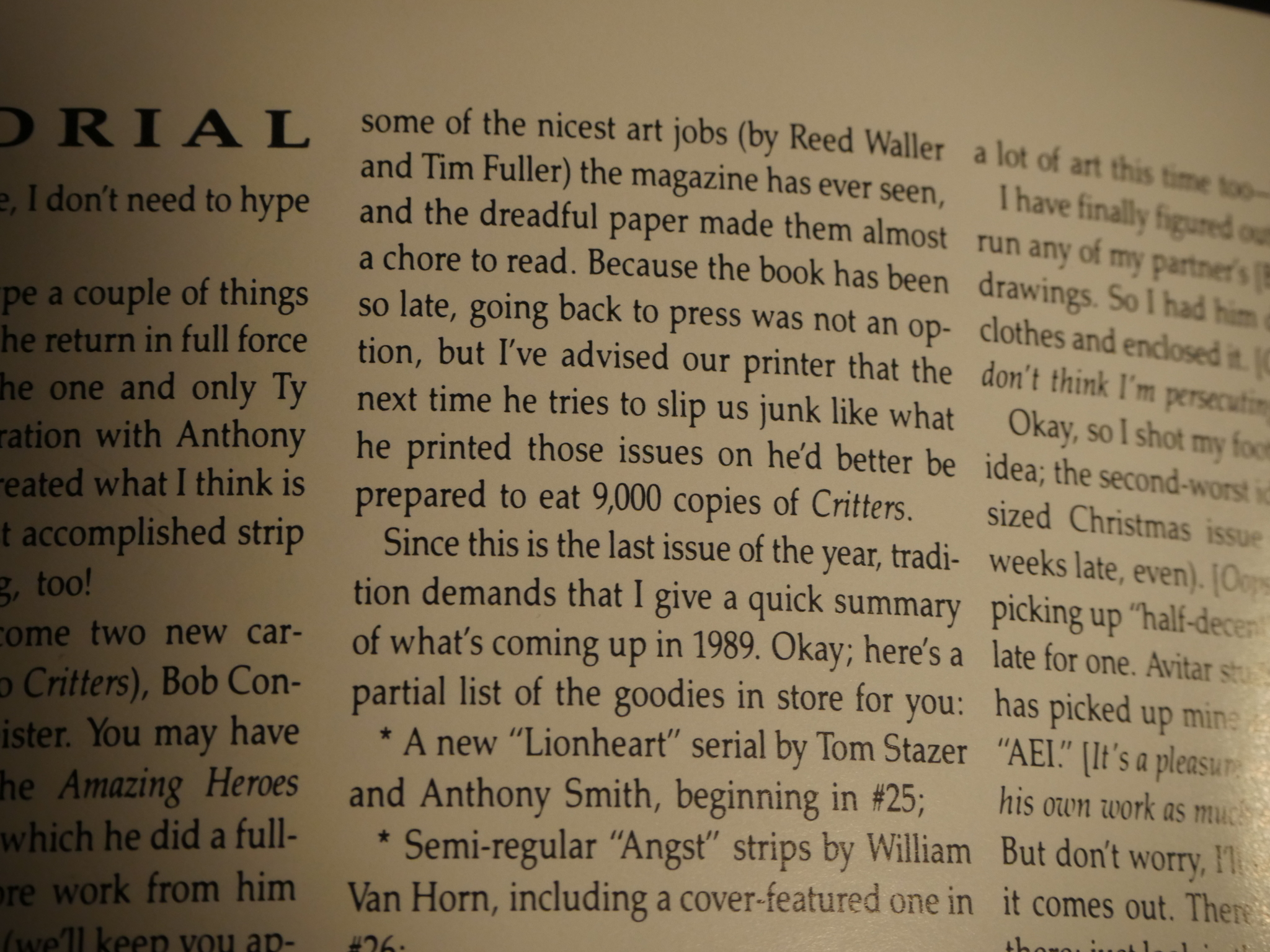
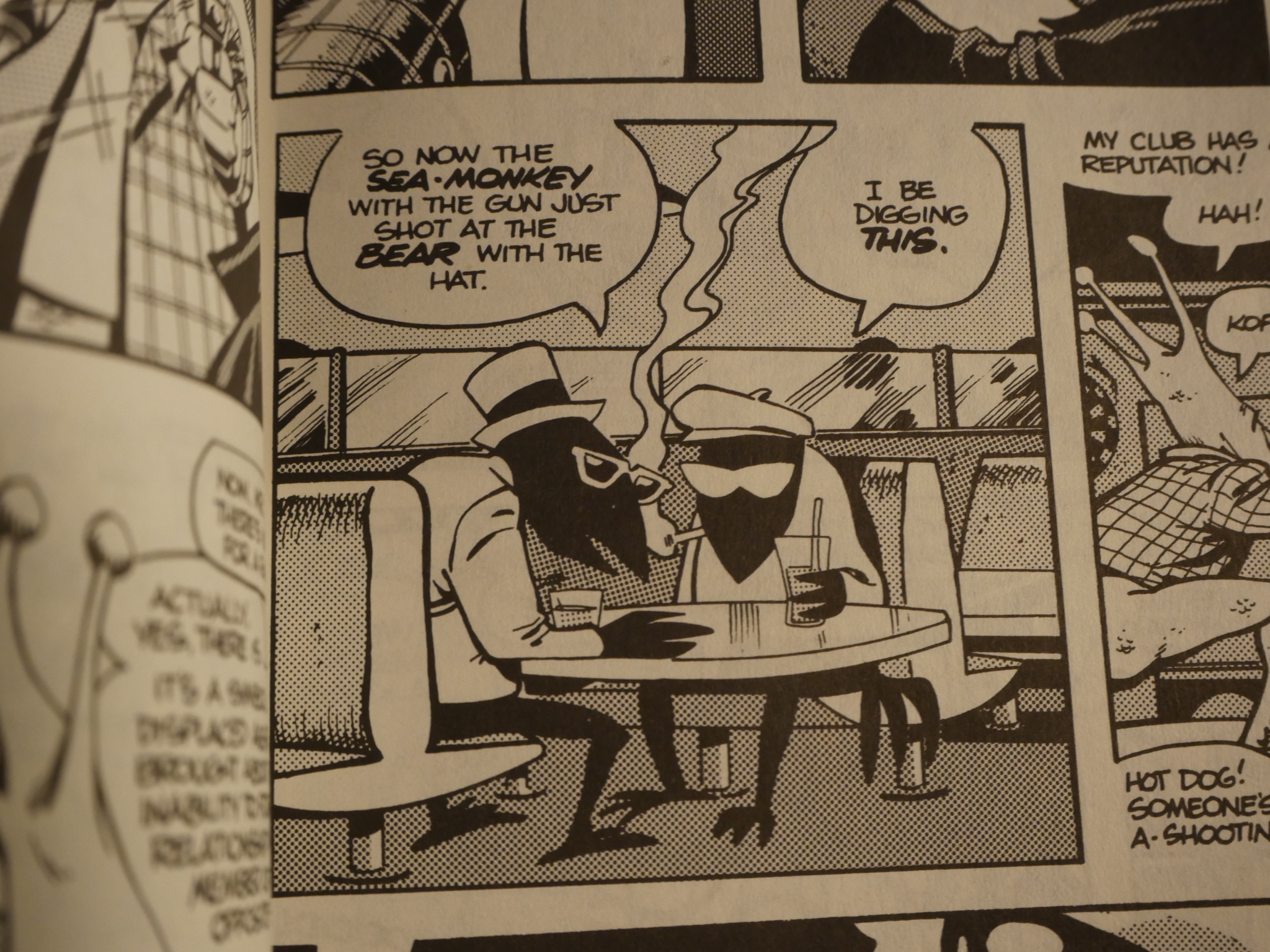
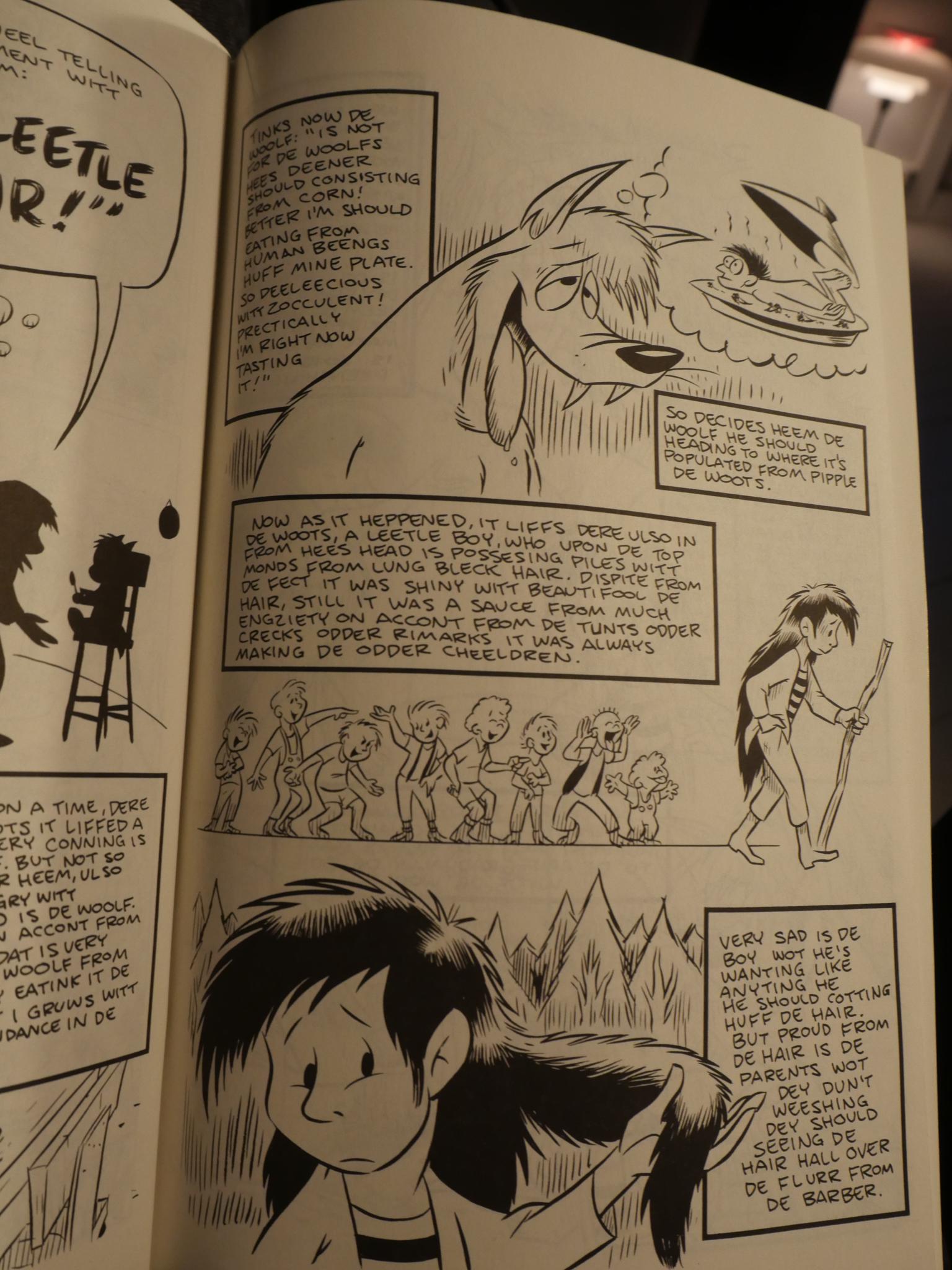
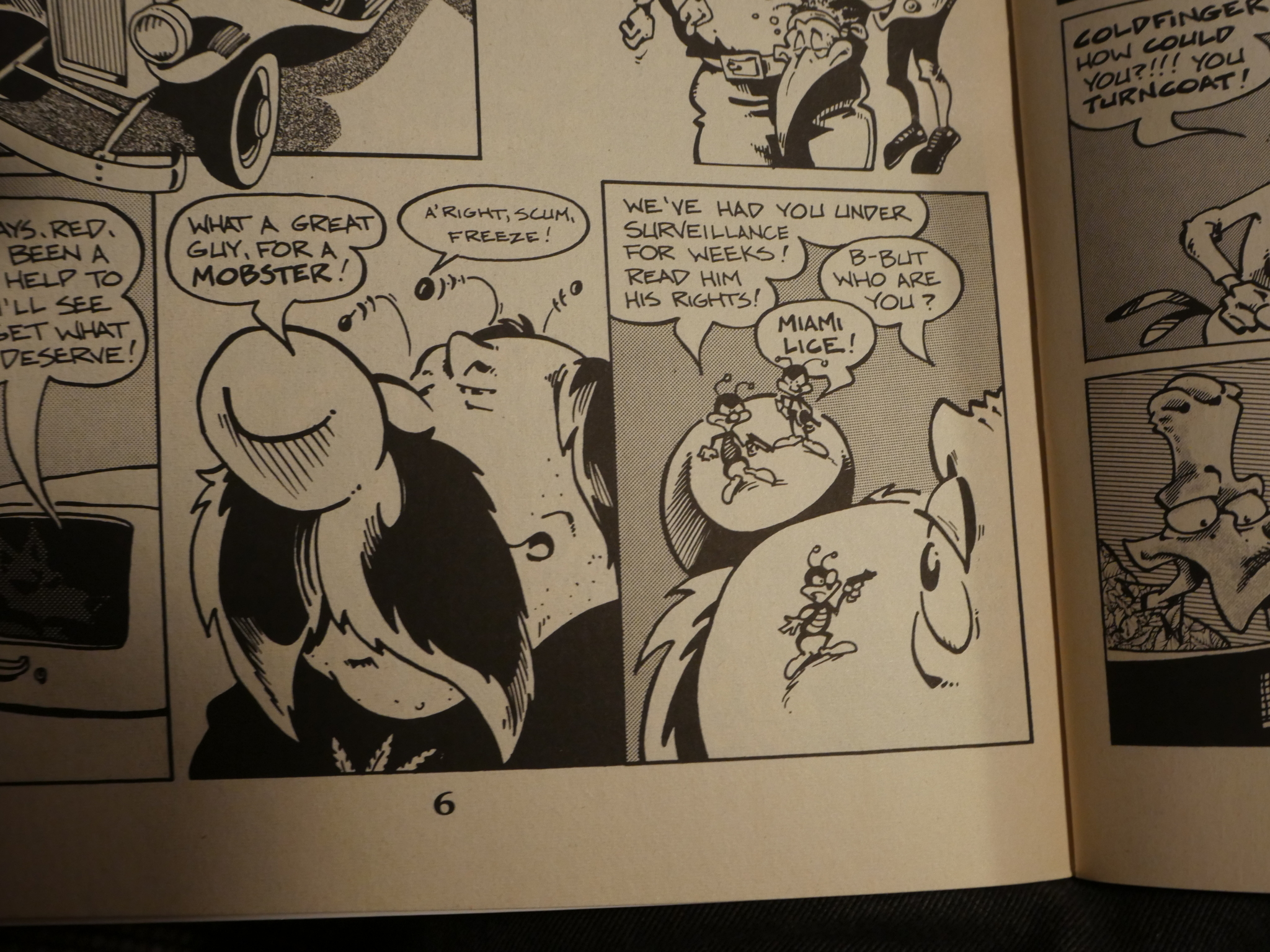

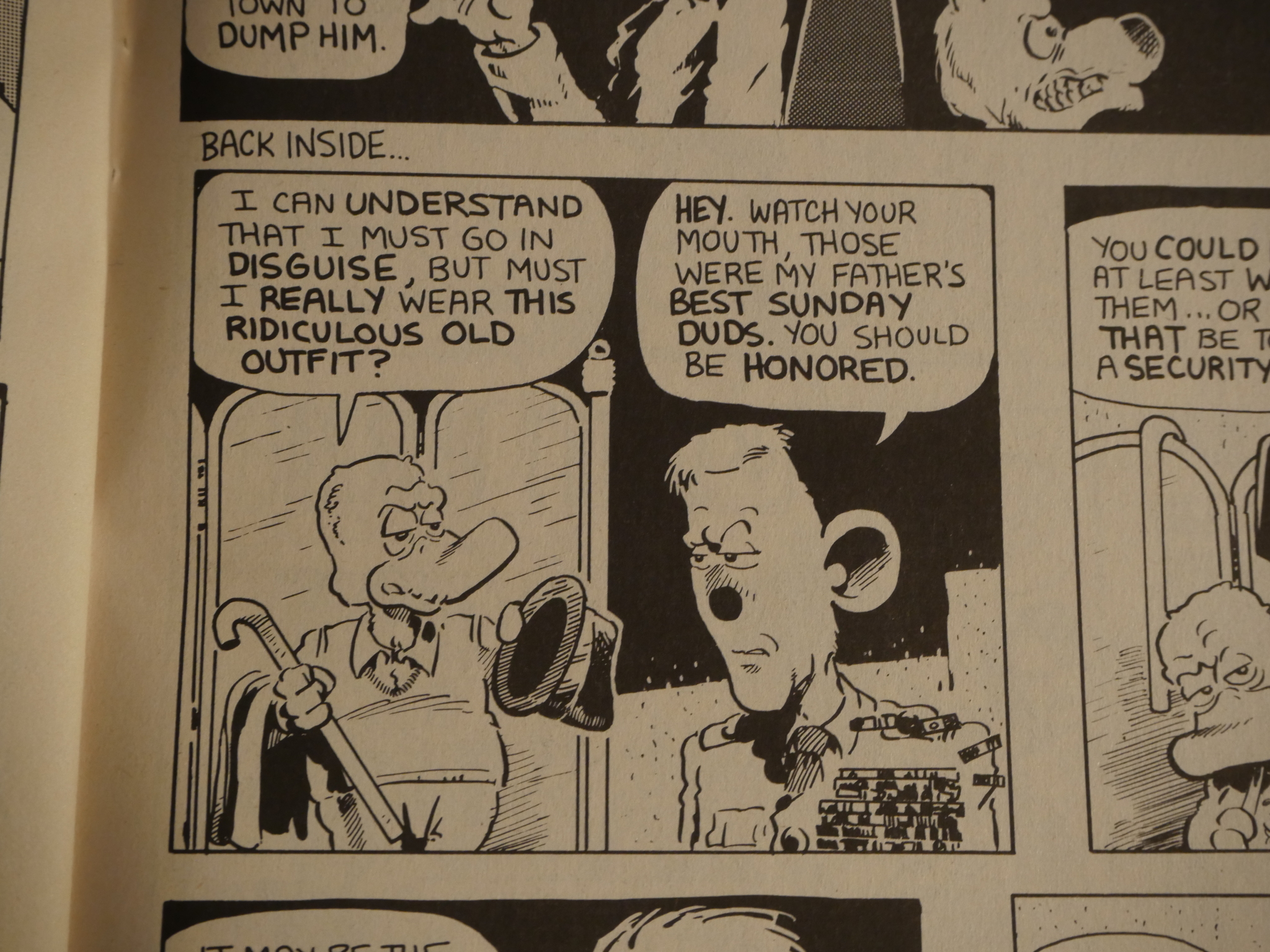

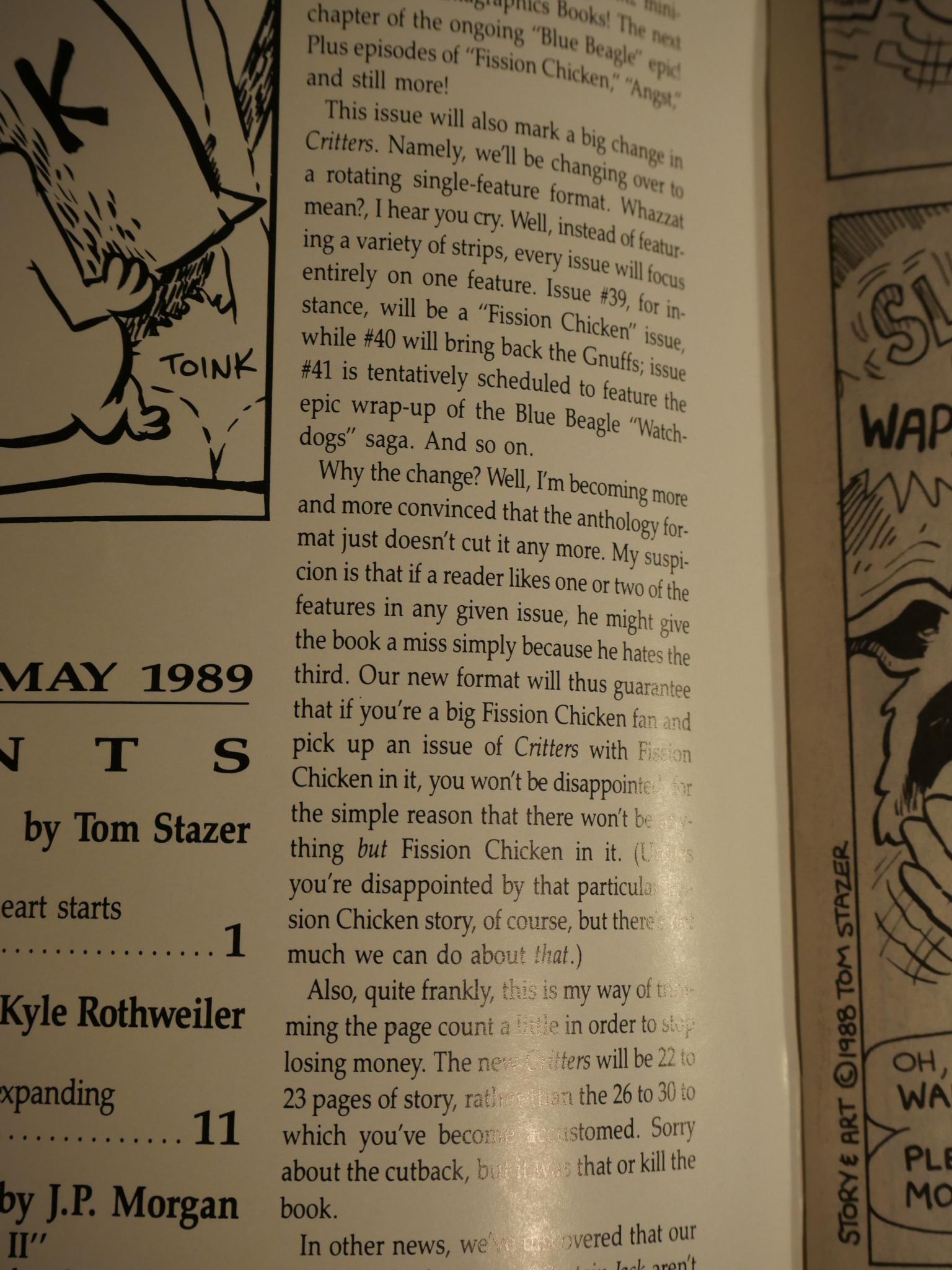
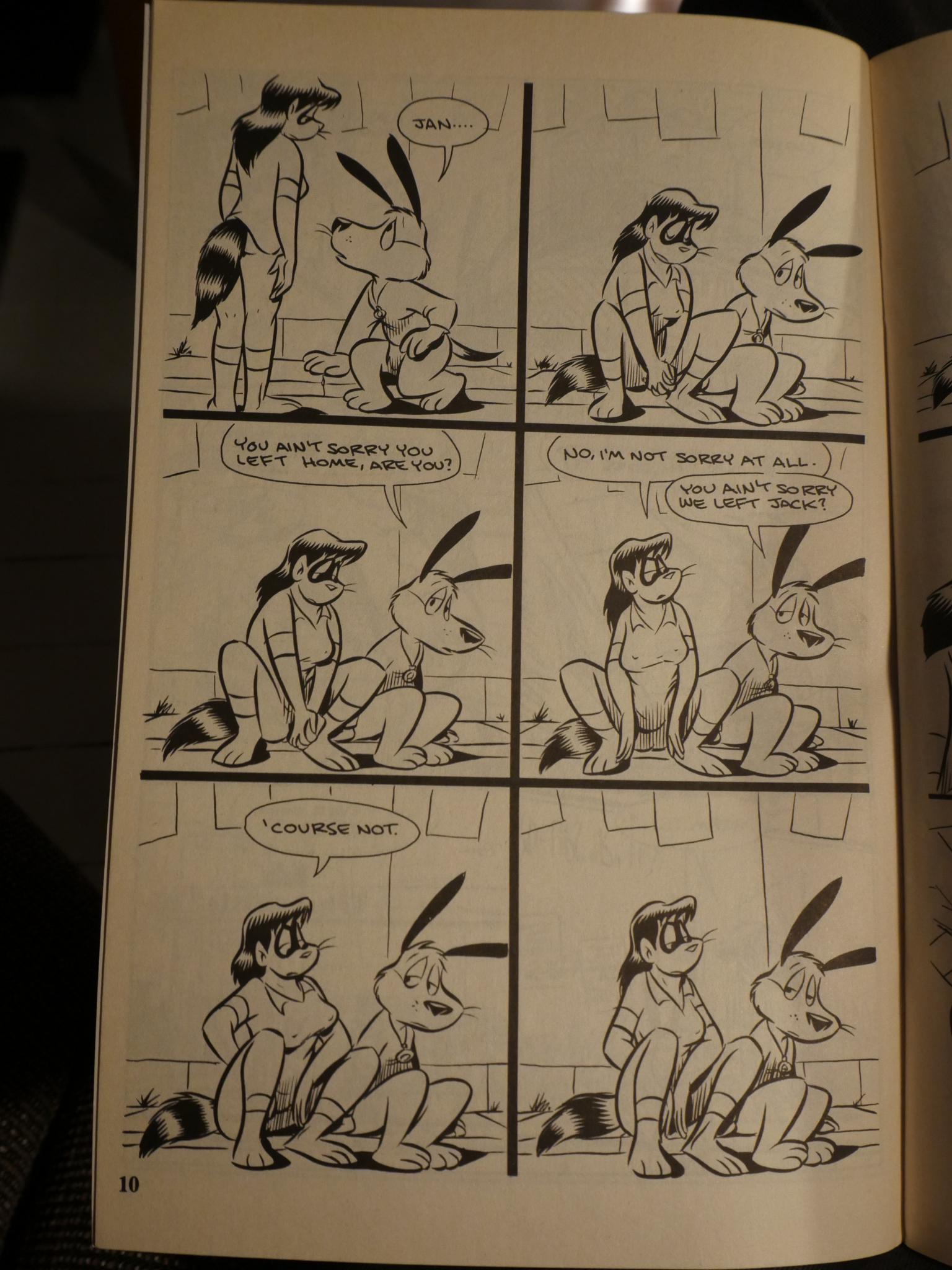
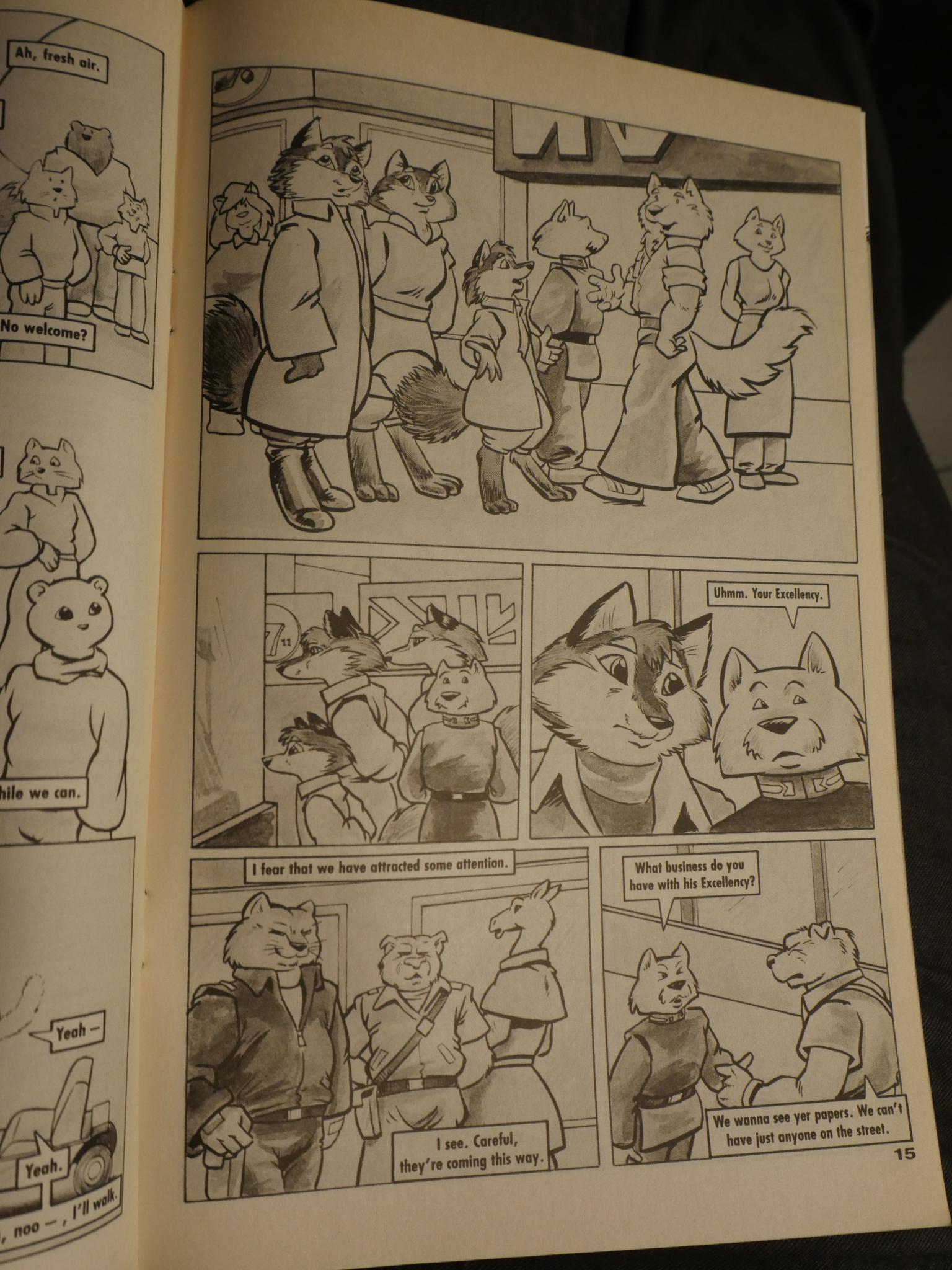
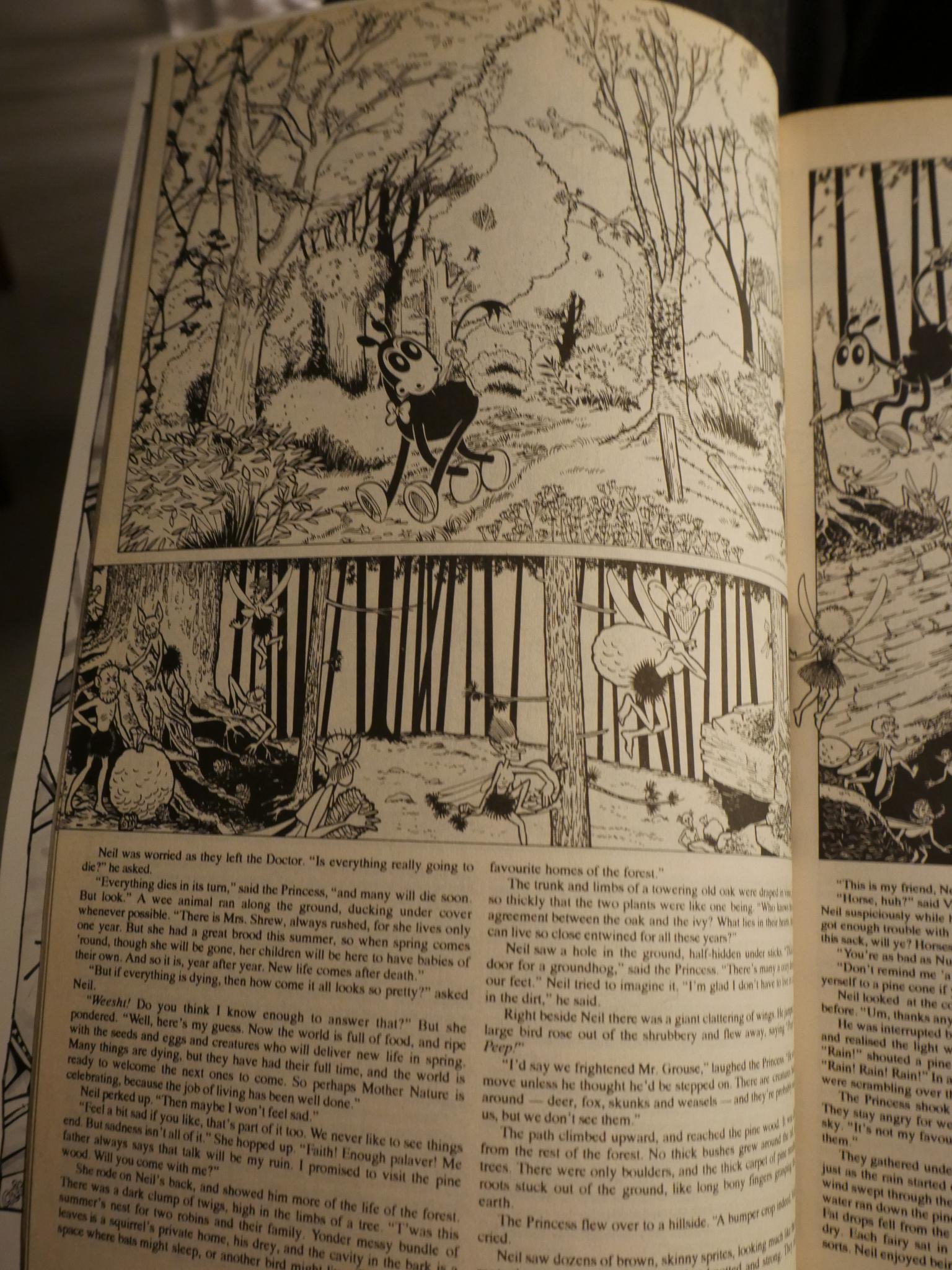
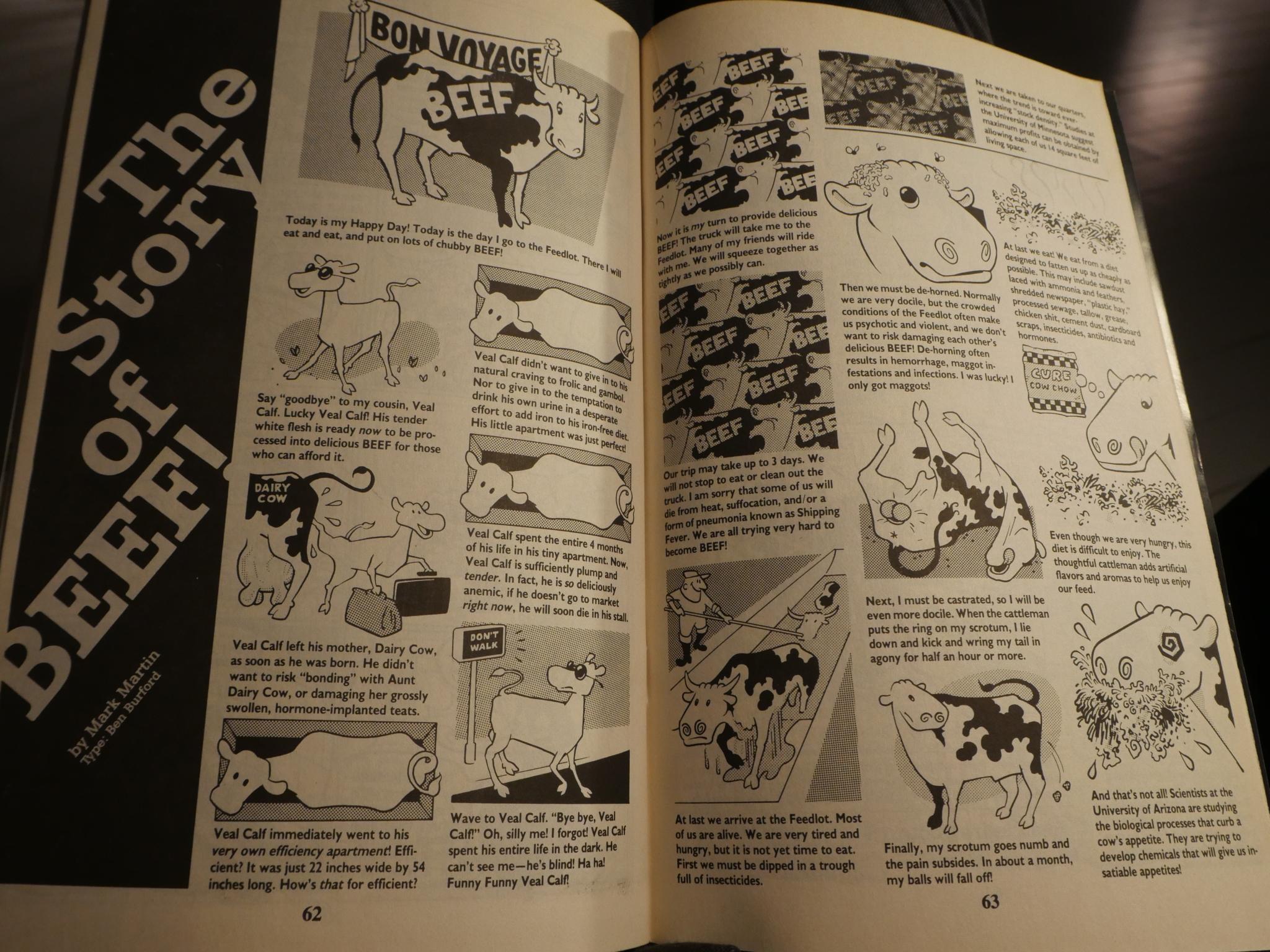
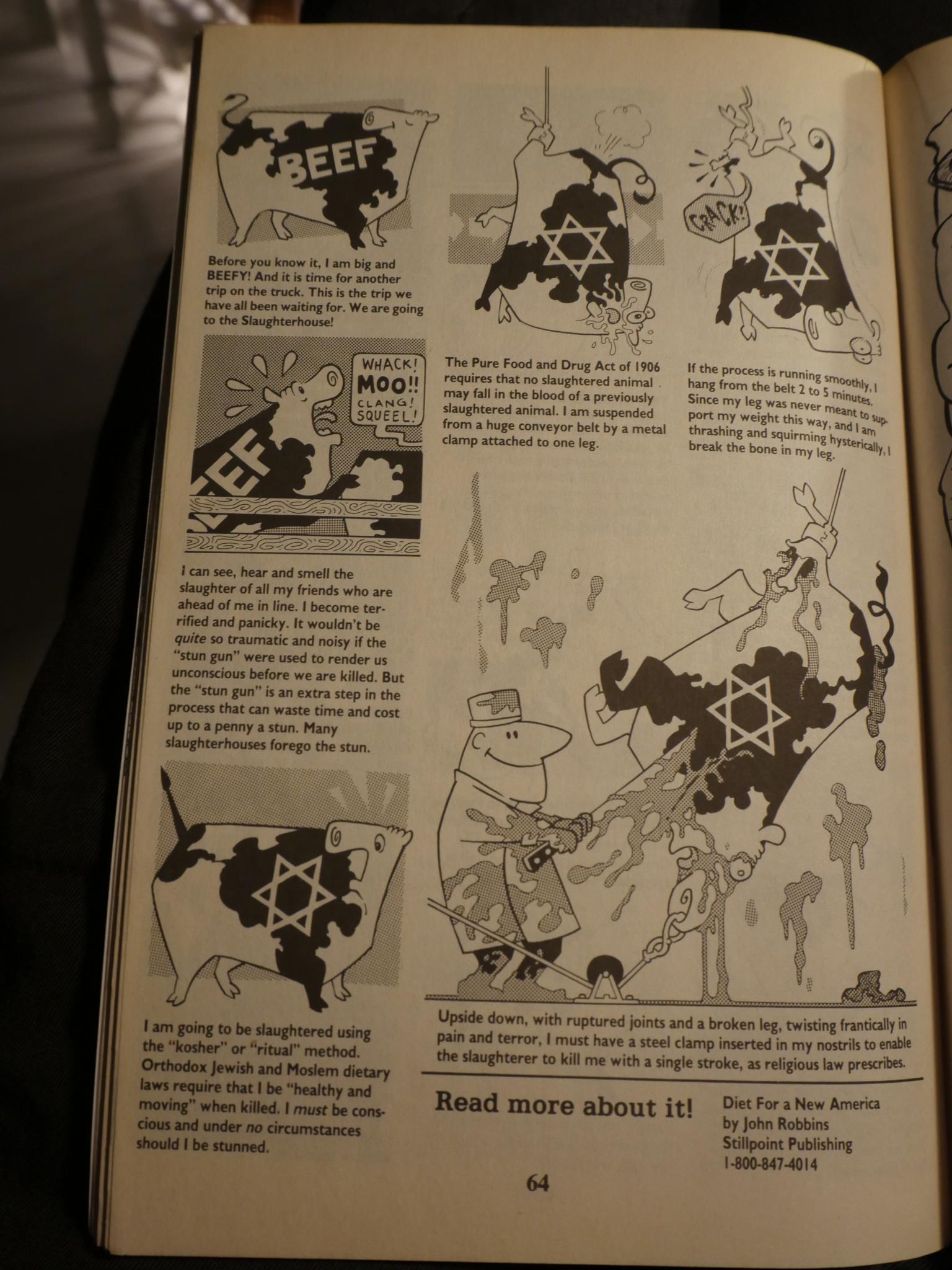
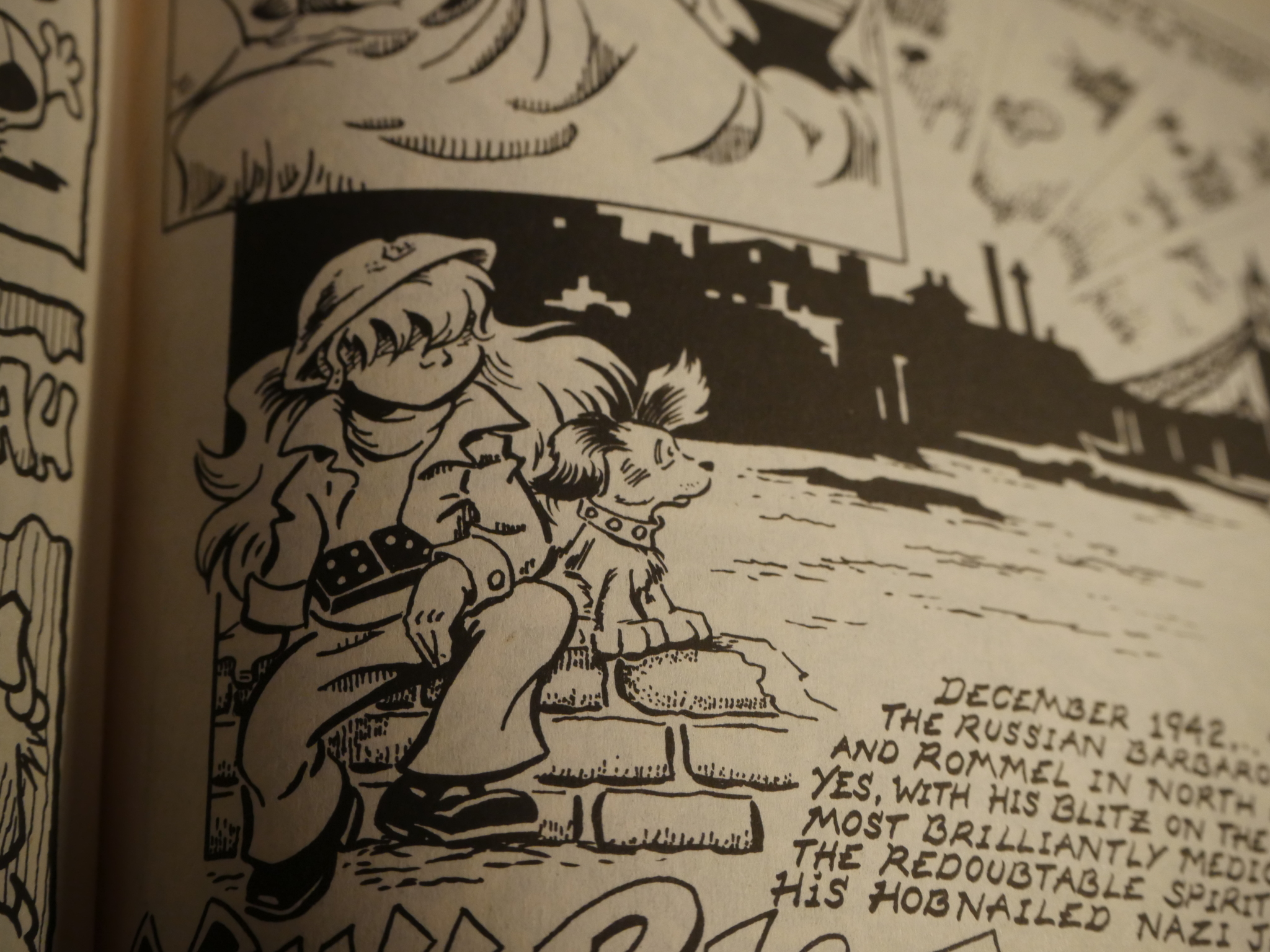
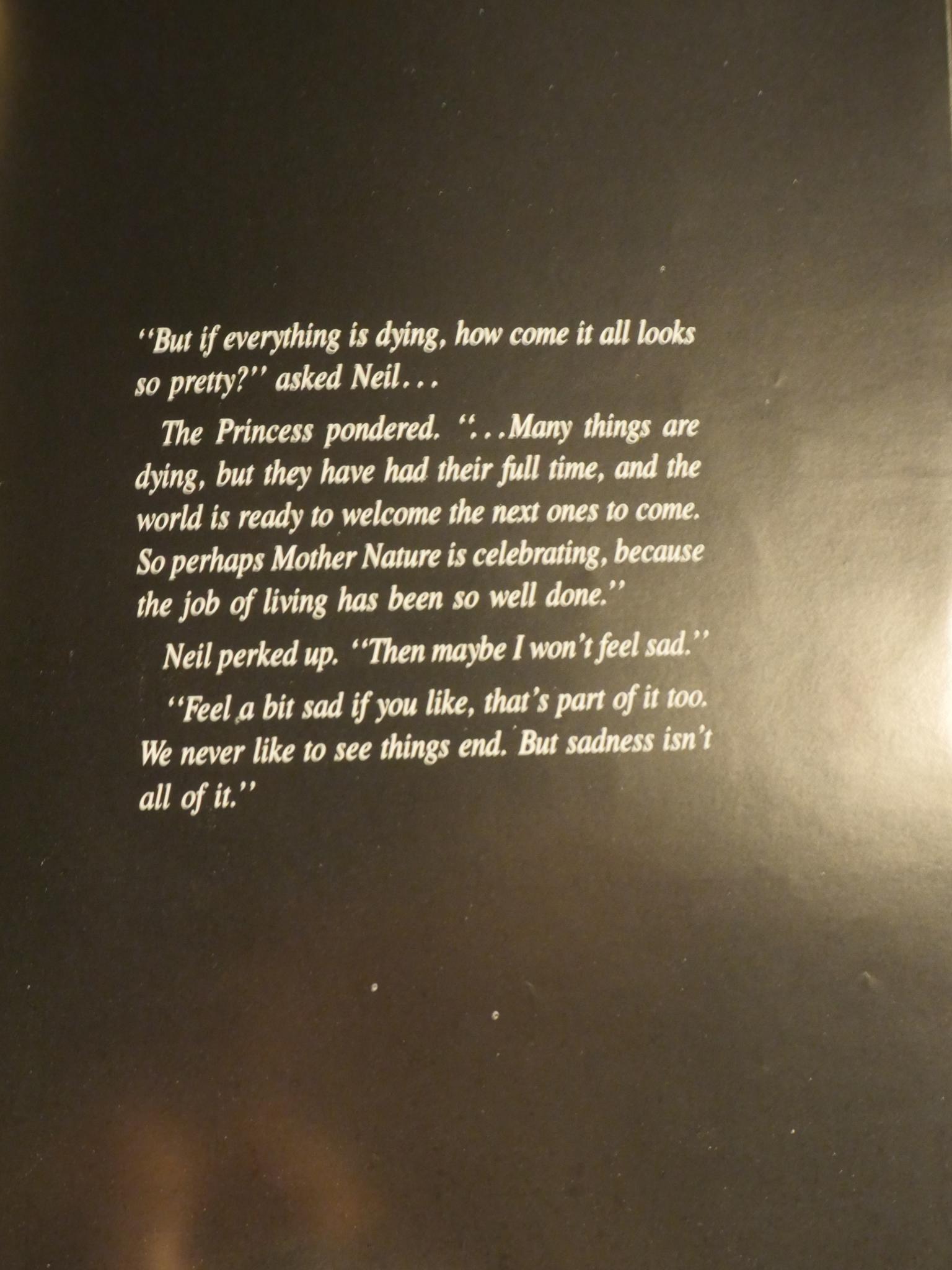
Lord. Never in all my born days had I thought I would see a comics publisher print a letter merely so he could tell its writer he was annoyed & that the writer didn’t know what he was talking about. What terrible business practice. That letter-writer probably dropped all Fantagraphics series immediately. Thompson could certainly have “fought his annoyance back” better.
I appreciate knowing how cattle are murdered in kosher & halal slaughterhouses, so thanks very much for including that page.